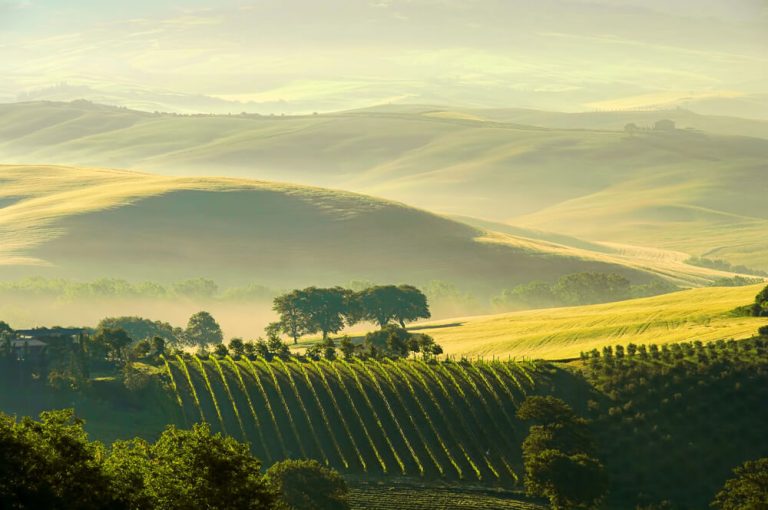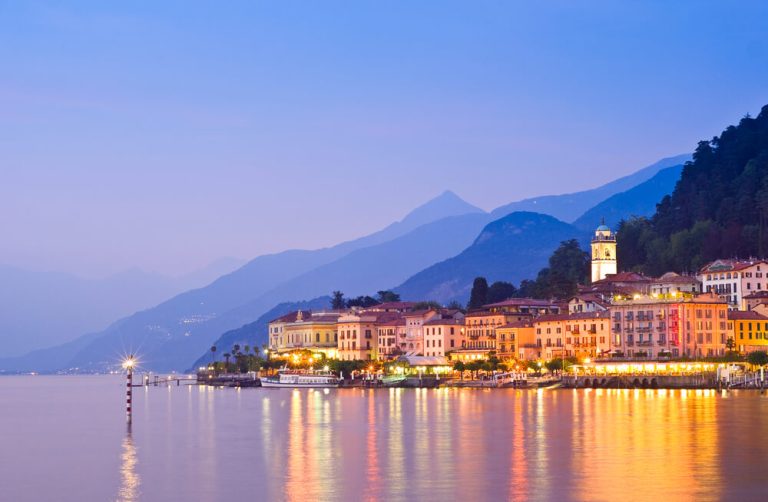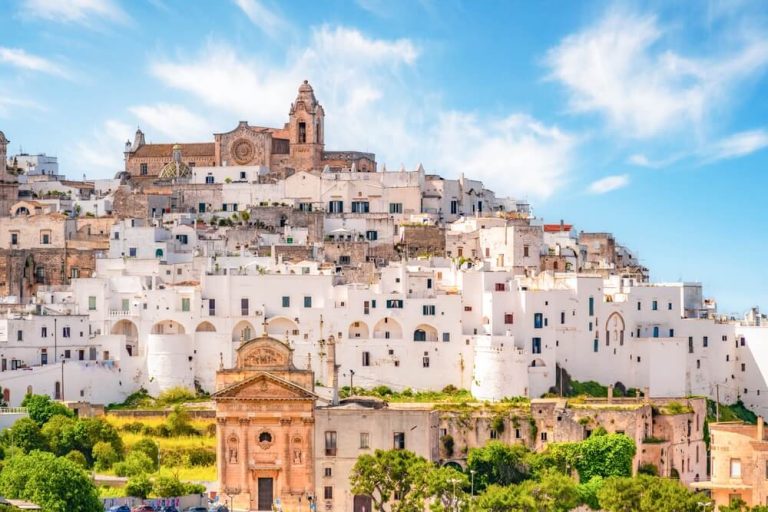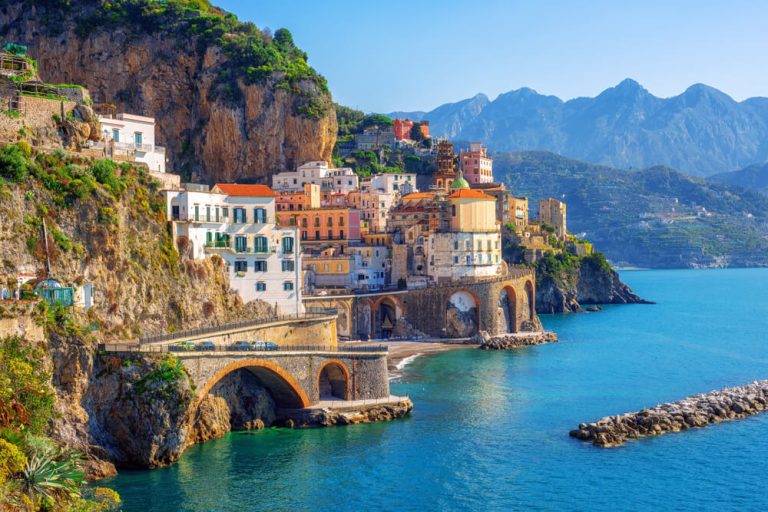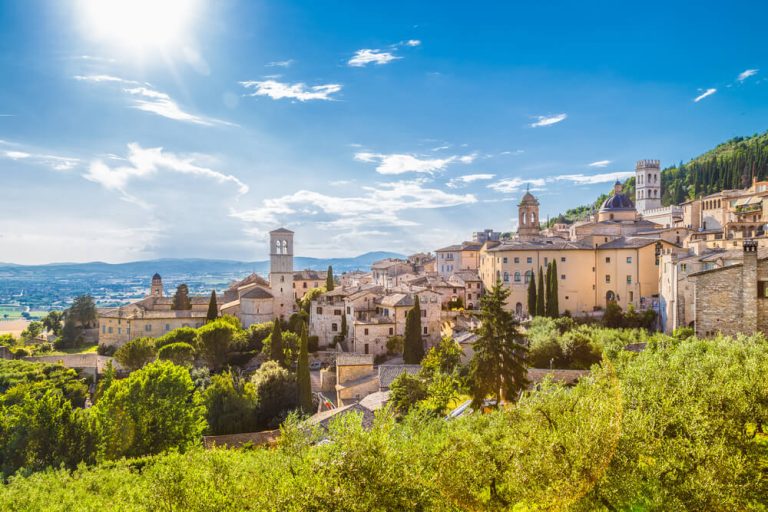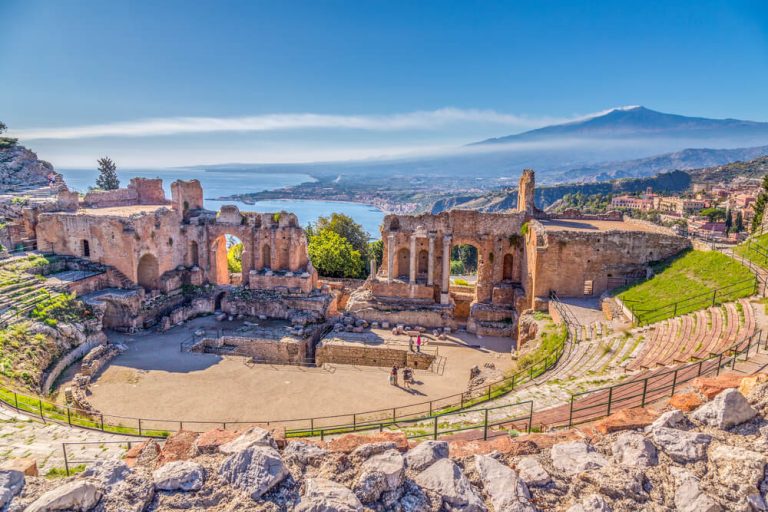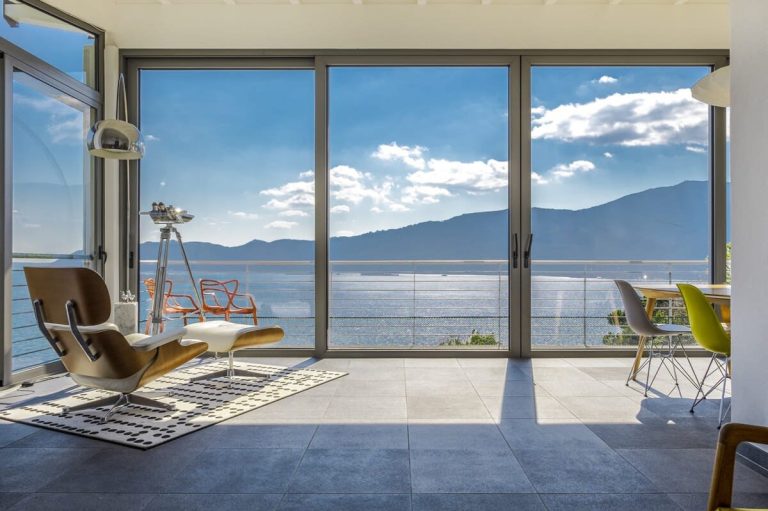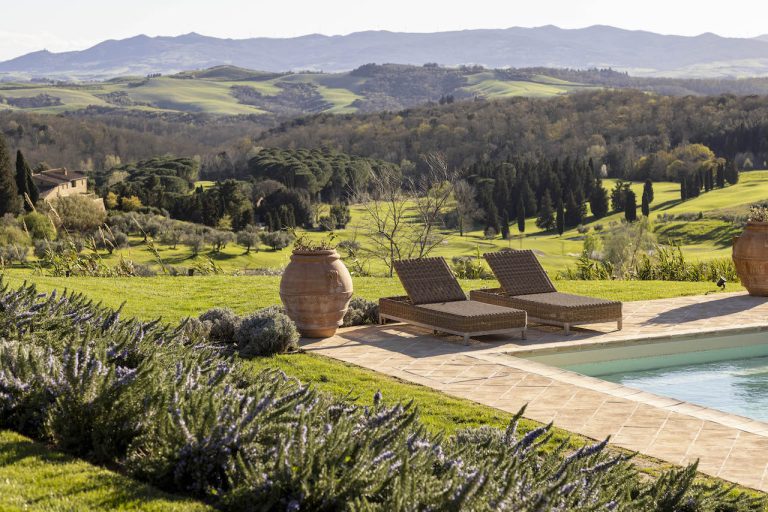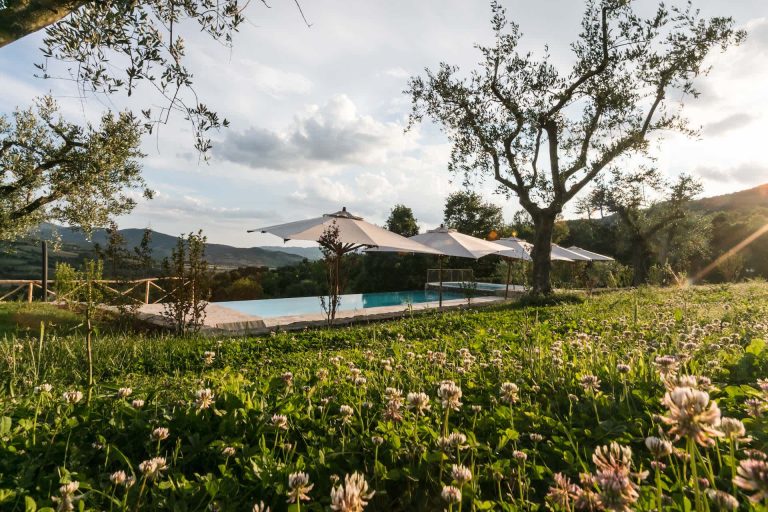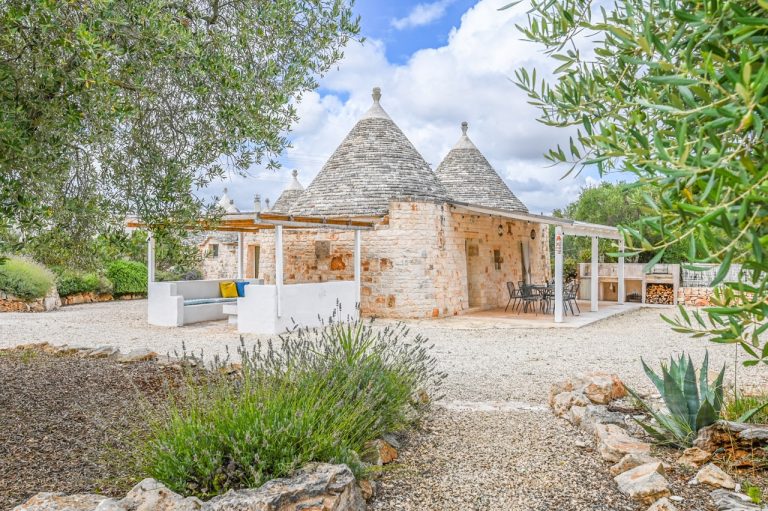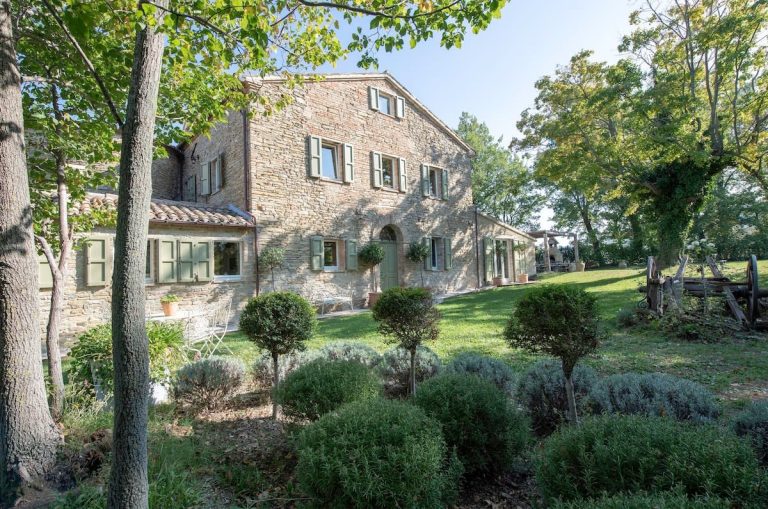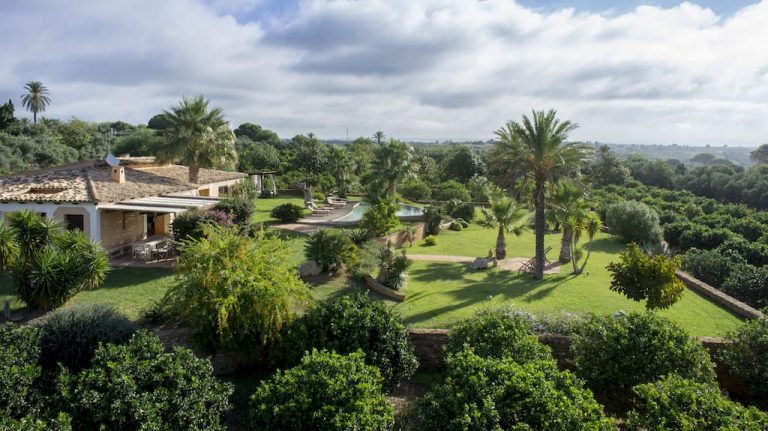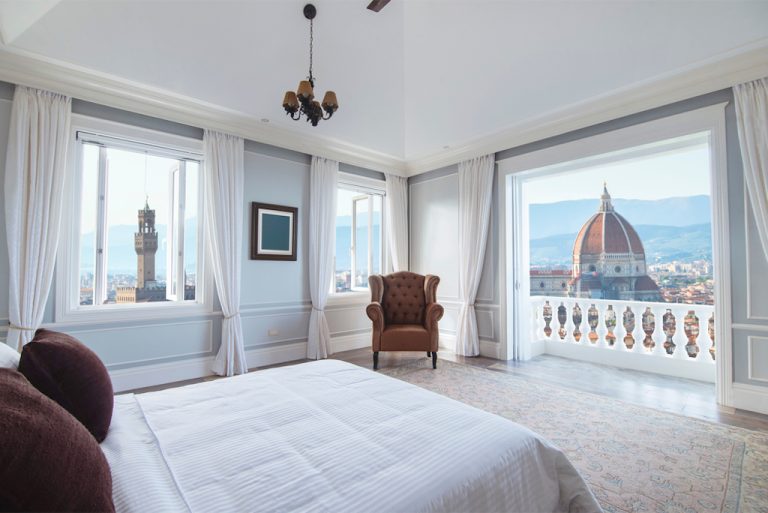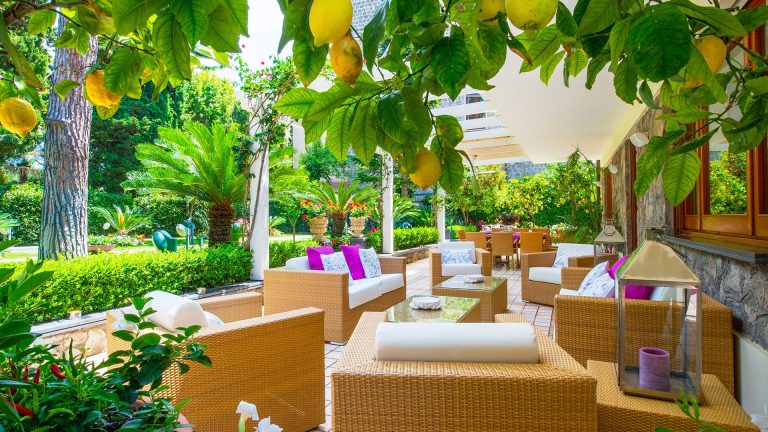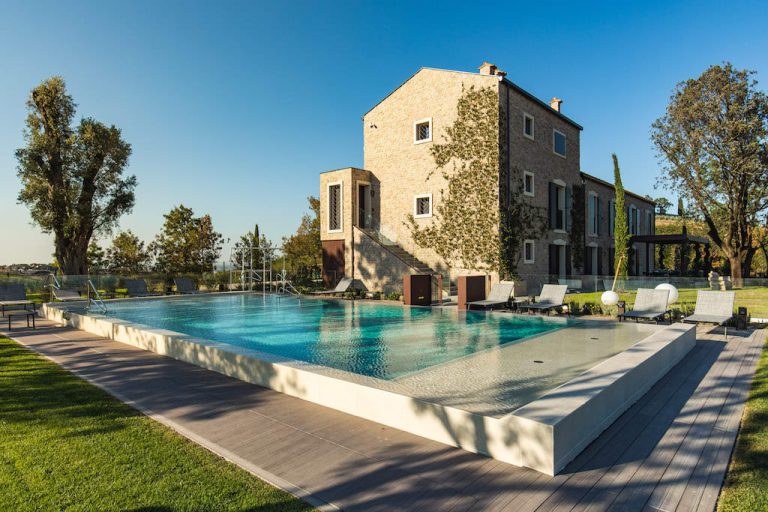Italy
Travel Guide
Everything you need to know
Italy
Italy is located in southern Europe. It is a country renowned for its rich history, its stunning landscapes, its breathtaking art and architecture as well as its world-class cuisine. The country is divided into 20 different regions from Trentino-Alto-Adige in the north down to Calabria and the island of Sicily in the south. Surrounded by the Mediterranean Sea, it offers holidaymakers a diverse blend of rolling countryside and cultural treasures – from the Colosseum in Rome to the canals of Venice and the Duomo in Florence – along with plenty of coastal charm and picturesque villages. It is the perfect destination for those seeking a luxury holiday with plenty of relaxation and unforgettable experiences thrown in.
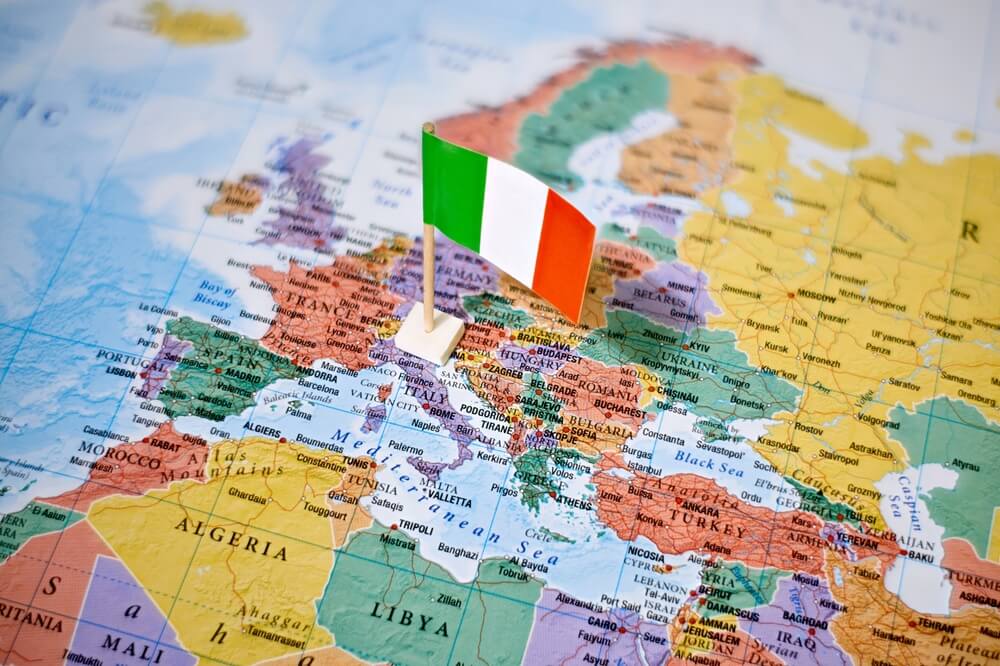
Italy Travel Guides
Our series of Italy travel guides will help you plan where you want to go on your next holiday to Italy. Whether you’re in search of a week on an Italian beach, two weeks in the countryside or just a weekend break in an Italian city, we’re here to help you plan your next Italian adventure.
How to get to Italy
Italy is very easy to reach either using public transport or by car. It is a very competitive route meaning that travel costs don’t need to break the bank either.
You can easily research prices to travel by air, train or bus at Omio. This is a really helpful travel website, aimed at simplifying the journey planning process. Just enter your dates, departure and arrival destinations and it will allow you to compare the different flight, bus and train routes as well as booking tickets. These can then be downloaded into a handy app to keep everything in one place. They also offer help to customers in 12 different languages so if you do have any issues, there is someone there to help.
By Plane
Italy’s busiest airports in terms of passenger numbers are Rome, Milan Malpensa and Milan Linate, Bergamo, Venice, Catania and Naples. However, there are also a number of other smaller airports including Bologna, Pisa, Bari, Verona, Florence and Ancona.
By Train
If you are already in Europe, then travelling to Italy by train is another option. Italy is one of the most rail-friendly countries in the world. A number of Italy’s most scenic train journeys cross over its borders to countries in the north. For example, the route through the Brenner Pass links Munich with Venice. And there are also fast train services between Milan, Turin and Paris. Alternatively, there is also an overnight train between Vienna and Rome.
Trainline is a useful site for planning train journeys within Europe. We like to think about it as a one stop shop for your train travel requirements. Their booking platform is easy to use and allows you to book in your preferred language and currency. Plus, they offer high levels of customer care with support before, during and after your journey if required.
Once arriving in Italy by train, it’s then easy to go on to reach your onward destination.
By Car
There are three main points of entry into Italy by car. These include the Mont Blanc tunnel from France, the Grand Saint Bernard tunnel from Switzerland and the Brenner Pass from Austria.
Once across the border in Italy, the country has a good road network. If you’re looking to get from A to B quickly, then it’s worth using the Italian Autostrada. These are fast roads but you do have to pay to use them. Toll booths will either require immediate payment or ask you to take a ticket, in which case payment will be made when you exit the motorway. Payment can usually be made using either a credit card or in cash. Just make sure you choose the correct lane – telepass or biglietto. The telepass is a device that will automatically deduct the toll from your bank account. The likelihood is that you won’t have one of these so instead you should opt for taking a ticket (biglietto).
The main north-south link road through Tuscany is the Autostrada del Sole which runs from Milan all the way down to Reggio Calabria. The A1 links Florence to Bologna in the north and with Arezzo and Rome in the south. There is also a fast road that leaves the A1 at Firenze Certosa and connects Tuscany’s capital to Siena. And the A11 connects Florence to Prato, Pistoia and Lucca before joining with the A12 which heads along Tuscany’s coastline to Genoa. You can check real time traffic information and journey times using the network of Italian autostrade here.
By Boat
With only a land border in the north, Italy is surrounded by sea, meaning arriving in Italy by boat is also an option for holidaymakers. With a 7,900 km of coastline, there are a number of ports, which between them welcome over 60 million cruise and ferry passengers each year.
Ferries travel from neighbouring countries such as France, Spain, Greece, the Ionian Islands, Albania and Croatia. Companies offering various routes include Corsica Ferries, Moby Lines, Grimaldi Lines, Medmar and Grandi Navi Veloci.
From France, ferries arrive in Italian ports such as Genoa, Livorno, Piombino and Savona. From Spain, you can take a ferry from Barcelona to Genoa and Civitavecchia. And from Greece, boats arrive in Bari, Ancona and Brindisi. Ferries from Croatia also land in Bari and Ancona.
And, of course, there are also ferries within Italy connecting one region to another. For example, you can catch a boat from mainland Italy to Sicily and Sardinia.
To book tickets on many of the main ferry and boat routes, head to Ferryhopper.
By Bus
For those on a budget, why not consider travelling to Italy by bus. The main bus companies that offer interntional as well as national routes in Italy are Flixbus (who cover 1200 destinations in 26 different countries), MarinoBus, Baltour, Marozzi and Cliento.
The most popular international bus routes include those from Barcelona, Berlin and Nice to Rome, as well as the route to Milan from Munich, Vienna and Prague.

How to get around Italy
Once you have arrived in Italy, you have a few options about how to get about during your holiday. We do usually recommend hiring a car – even if you don’t use it every day, it will give you so much more freedom and allow you to explore parts of the country that may be hard to reach using public transport. However, it’s good to understand all the options open to you. And our advice does differ dependent on where your chosen Italy villa rental is located.
Train
Italy’s main train operators are the state founded and state run Trenitalia and privately owned Italo. Both provide super-efficient high-speed links between major cities.
Trenitalia’s trains are divided into 3 categories – Alta Velocita (AV), Intercity (IC) and Regionale. These trains run between Italy’s major cities and reach impressive speeds of up to 300 km per hour, 250 km per hour and 200 km per hour respectively.
The fastest of these – the Alta Velocita (AV) or high speed trains – are the most expensive trains but offer very comfortable seating which must be reserved in advance. Within this category, there are three sub-categories – the Frecciarossa, Frecciargento and Frecciabianca. Expect to find different classes on travel on these trains – standard, premium, business and executive – with prices increasing accordingly. Frecciarossa trains also have a staffed bar and café on board, whilst in some classes you will also get food delivered to your seat.
The second category is the Intercity (IC) trains. These are still fast services and again operate between the major cities. If you are travelling to or from Tuscany to other regions, you may also want to take advantage of the Intercity Notte service. These are overnight train services that run between the north and south of Italy. Don’t expect the same level of food service on these trains though – there will probably only be a food vending machine on board at most.
Finally, the Regionale services are the cheaper, slower trains. As they travel between the major hubs, they stop at most stations. These are therefore a good option if you’re looking to reach some of Tuscany’s smaller towns and villages. These trains are also lovely option if you’re not in a hurry as they’ll allow you to enjoy some spectacular views of the Tuscan countryside or coastline en route to your destination.
Private train company Italo has just two types of train. Their AGV and EVO trains are equivalent to Trenitalia’s Frecciarossa an Frecciargento services when it comes to both speed and service. Italo’s trains have three different classes to choose from – smart, prima and club.
Almost all trains in Italy, even the slow ones, will have charging points for phones and laptops. Italo and Freccia trains also have free WIFI. In short, Italian trains are superb. Whilst we can’t guarantee they will always run on time, delays of more than 10 or 15 minutes are rare. And, when you factor in traffic and parking, it’s usually a much faster way to get from A to B in Italy. The only caveat is arguably the risk of industrial action. Scioperi (strikes) can bring public transport to a standstill but there is usually plenty of advance notice of any industrial action so you can plan around it.
Train travel in Italy is no different to anywhere else in the world: the sooner you book, the cheaper your train fare will be. It is possible to book tickets directly with the train operator. But as more than one operator may be travelling on that route, a better option to use to book tickets is Trainline. They will show all available ticket options from every provider. They also recognise both English and Italian names for stations and destinations which can prove to be super useful too.
Just one word of caution if travelling by train. If you buy your ticket at the station, or if you’re travelling on a Regionale service with a paper ticket, it is important that you validate your ticket at the machines in the station before boarding the train. Not doing so can result in a rather hefty fine.
Renting a car and driving
If you are driving your own car to Italy, make sure you have the correct equipment with you. Legally you must carry a reflective safety vest and safety triangle. At certain times of year, your vehicle will also need to have been fitted with winter tires or you will need to have snow chains. Dependent on your vehicle, you may also need headlamp beam deflectors. Make sure you also have a copy of your vehicle insurance documents and V5 registration document. If coming from the UK to Italy with your car, your vehicle must display the letters UK. This can be either incorporated in the car registration plate or can be displayed as a separate sticker.
If you are hiring a car in Italy, book as early as possible. Car rental rates only seem to get more expensive as the holiday approaches. Bookings For You recommend Auto Europe. They offer free cancellation so if your plans do change, you can easily amend your booking.
If flying in to Italy and renting a car from the airport, we recommend you try and choose one of Rental Car agents based on site. You should also be aware that you usually need to be at least 21 years old to rent a car in Italy, and if you’re under 25, you can expect to pay a young driver’s surcharge. On arrival you will be required to provide a credit card to the car rental company.
Most cars are manual so if you want an automatic, you must specify this in advance. We recommend you hire a small car rather than larger vehicle (assuming you can fit the luggage in!) Many of Italy’s streets are narrow and a small car will allow you to manoeuvre your way around more easily.
If you are touring around Italy, you can pick up and drop off your vehicle in different locations. However, if you want to do this, you will typically find that rental options are more limited. You may also find that there is an additional one-way surcharge.
Compare quotes for your car rental in Italy.
Whether you are hiring a car in Italy or bringing your own, you will also need to have the correct license. Dependent on your nationality, that may be a UK Driving license, an EU license or a non EU license with an International Driving Permit.
There are a few rules and regulations you should be aware of when driving in Italy.
- It is compulsory to wear a seatbelt. Children under 36 kg or less than 150 cm in height must also use an appropriate car seat or booster seat.
- Unless otherwise stated, the following speed limits apply in Italy:
- Motorways 130 km per hour (kph) maximum
- Main roads outside built up urban areas 110 kph
- State roads 90 kph
- Urban roads 50 kph
- On the motorways and in some towns, you will find signs for Autovelox (speed cameras). On the motorways, you may also see an average speed system – ‘Sistema Tutor’ which averages your speed between 2 points on the road. Signs saying ‘Polizia Stradale’or ‘Controllo electronico della velocita’ will tell you that speed monitoring systems are in place.
- When in city centres, pay close attention to the ZTL zones (Zona Traffico Limitato) or Area Pedonale(pedestrian areas). A special permit is required to drive in these areas and heavy fines apply if you enter without one. Video cameras normally record details of your car registration number as you enter.
- Disobey the speed limits or enter a restricted traffic zone and you will can receive a fine through your letterbox months or even a year after your transgression. Or, if you’re a non EU resident and are caught making a traffic offence, the police officer can insist on immediate payment. If you refuse to pay, the police officer is legally allowed to confiscate your vehicle.
- It is illegal to text or hold a phone whilst driving.
- It is illegal to drive with a blood alcohol level over 0.05%.
- Unlike in the USA, you can’t turn right on a red light in any circumstances. You must wait for the traffic lights to turn green.
- When on a motorway, you are legally required to drive with your headlights on even on a bright, sunny day.
Wherever you opt to park, you will often find that parking spaces are marked with different colours and it’s important to understand what they mean.
Blue Spaces: This is paid parking. Payment can either be made at a nearby machine or via an app (details of which would be posted on the machine). Alternatively, you may need to visit a tabacchi to purchase a parking ticket. It’s useful to have coins to hand for payment machines but most now also accept credit and debit cards. That said, it is working checking the signage as some of these zones can still be free of charge at certain times of the day or on Sundays.
White Spaces: These are free but you make sure that they are open to everyone as sometimes they are reserved for residents only. Even if it is free parking, it may also only be for a limited period of time. Car rentals in Italy usually provide a parking disc (disco) which you will need to display on your dashboard to show your arrival time. However, if you don’t have one, you can purchase one at a tabacchi.
Yellow Spaces: These are disabled parking or loading zones.
If a space is signposted as passo carrabile then don’t park there! This is a tow away zone.
In larger cities, you will also find private car parks and private garages. These tend to be the most expensive parking options.
Wherever you choose to park, don’t leave any valuables on display. Whilst Italy is a safe country, you should avoid leaving items on display that might tempt someone to break in. Even when at the service station, make sure your car is locked when heading inside to pay. And, if you can possibly avoid it, don’t even leave valuables locked in the boot.
Bus
Buses are a convenient and affordable way to travel around Italy. They come in particularly useful when exploring the major cities or when you need to go to and from smaller towns and villages that aren’t linked accessible by train.
The bus can also offer a pretty impressive sightseeing experience. For anyone visiting the Amalfi Coast, I would never recommend driving yourself along the coastline – it’s far too scary navigating those clifftop roads. Instead, take the bus so that you can keep your eyes on the views and not the traffic ahead.
There are a few different types of bus service. The first are intercity buses connecting major towns and cities. Second are the regional and local buses operating within specific regions and towns. You then have airport shuttle buses and finally, there are tour buses. These provide guided tours of cities or regions.
However, with well over 100 different bus companies operating in Italy, working out timetables and routes can be confusing.
Information about buses online is generally limited and not particularly user friendly. You may also find that services are much fewer at the weekend than on weekdays. And they may well not operate at all on public holidays. As a result, if you’re already in Italy, you may want to visit the bus station in person to check timetables and book tickets.
Alternatively, bus tickets in Italy can now be purchased online at Trainline. Bus tickets in Italy typically go on sale about three months before the date of travel. Booking early will ensure you take advantage of the cheapest fares.
Boat
There are ferries within Italy connecting one region to another. For example, you can catch a boat from mainland Italy to Sicily and Sardinia.
To book tickets on many of the main ferry and boat routes, head to Ferryhopper. For the most popular boat routes which are active only during high season (for example boats from Amalfi to Capri, Sorrento to Ischia or from Ischia to Positano), we advise booking as early as possible to avoid disappointment.
If you are visiting the Italian Lakes, then boat timetables for Lake Como, Lake Garda and Lake Maggiore can be accessed at the Navigazione Laghi website. It is not necessary to book tickets in advance.
If you are visiting Venice, it’s worth considering purchasing a Venice waterbus and mainland bus pass. The ticket is valid for Venice, Venice Lido, Murano, Burano and the Torcello Islands as well as for the bus in Mestre and Marghera. You can purchase 1, 2, 3 and 7 day tickets as well as tickets in advance for just 75 minutes.
Florence
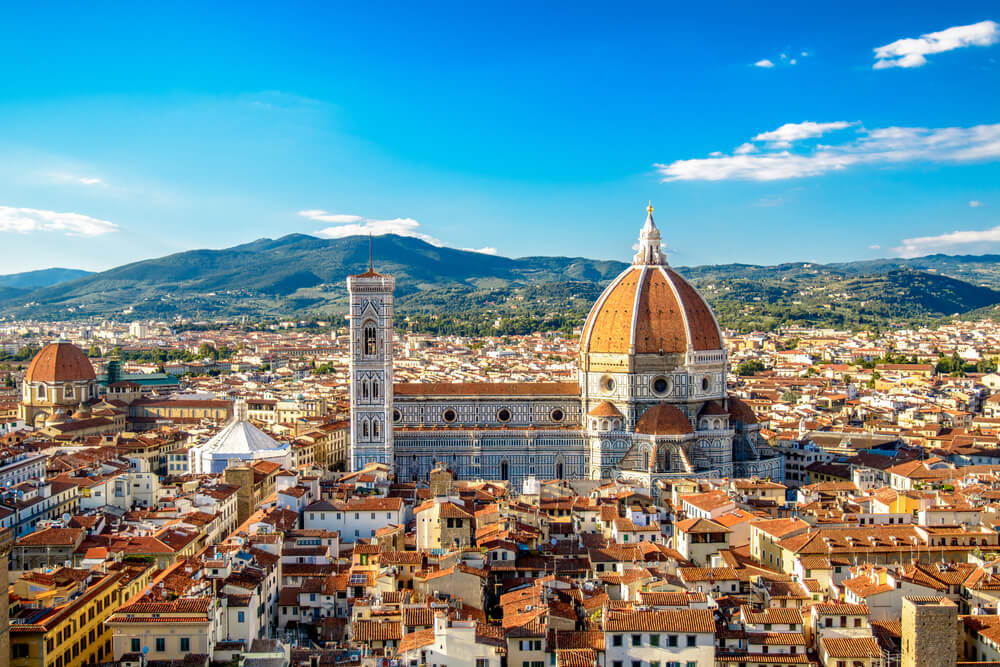
Introduction to Florence
Florence is Italy’s most populated city. It’s also one of the world’s most iconic cities. The historic centre of Florence is a UNESCO World Heritage site and attracts millions of tourists each year. Home to the Duomo, Palazzo Vecchio, Ponte Vecchio and the Palazzo Pitti, Florence is renowned for its Renaissance art and architecture. Michelangelo’s David is housed in the Galleria dell’ Accademia, Botticelli’s Birth of Venus sits in the Uffizi Gallery and Brunelleschi’s dome atop the Cathedral of Santa Maria del Fiore dominating the Florence skyline. There is even more to Florence than its art and architecture though. Florence it also a city of beautiful gardens which provide an opportunity for a moment of calm and quiet during days spent sightseeing. The Iris Garden, Bardini Gardens, Rose Garden and the Boboli Gardens are all well worth a visit.
Tips for navigating the city
Florence is super easy to discover on foot. The city’s historic is approximately 5 square kilometres ensuring everything is within easy walking distance. Many of Florence’s central streets are also pedestrianised meaning going on foot is the only option.
However, if you want to explore a bit further afield than the centro storico (and we recommend that you do), Florence does have a tram network. This connects the city with the airport as well as with those neighbourhoods outside the historic centre. Contactless payments are accepted on board. Trams tend to run frequently Monday to Friday. However frequency tends to decrease at the weekend.
There is also a good bus network in Florence run by Autolinee Toscane. If you want to enjoy one of the best views of Florence at sunset, take the number 12 bus from Piazza Ognissanti to Piazzale Michelangelo. This sits on the hillside overlooking Florence and has terrific of the city, particularly at sunset. However – there is one caveat. You can expect plenty of other holidaymakers to be enjoying it with you!
Another good bus route to know about if visiting Florence is the number 7 bus from Santa Maria Novella railway station to Fiesole. Fiesole sits in the outskirts of Florence and is one of its most affluent suburbs. It is also where you can discover some outstanding Etruscan and Roman remains.
Buses in Florence are excellent value with tickets costing approximately two euros and valid for 90 minutes.
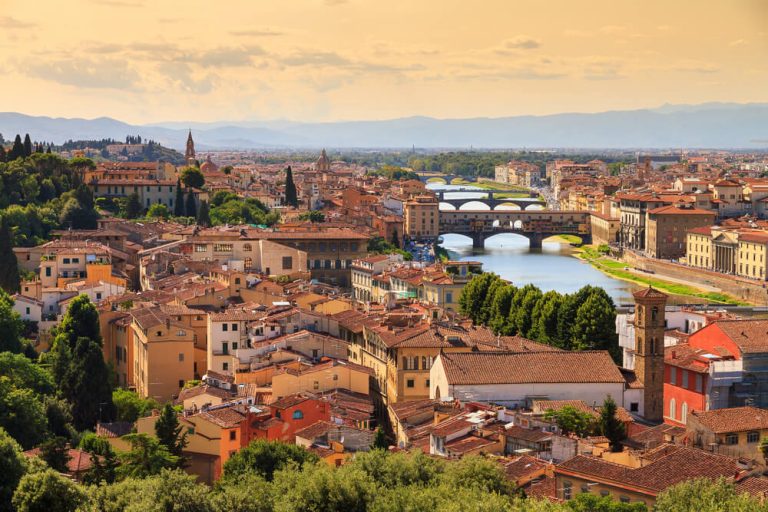
Siena
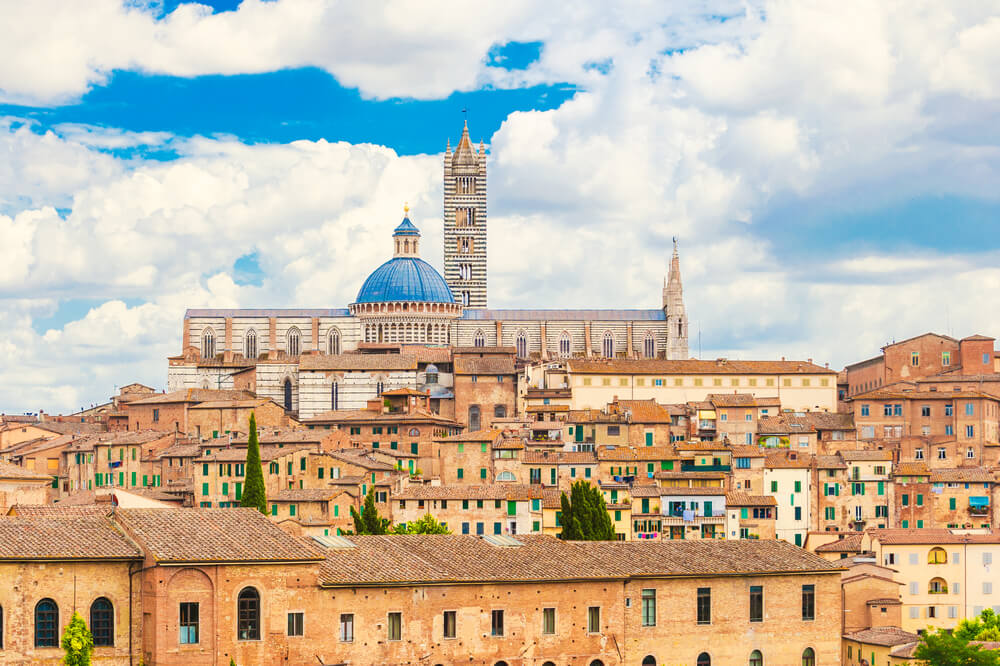
Introduction to Siena
Siena is home to the beautiful Piazza il Campo. This sloped square, shaped like a scallop shell, is in turn where you will find the Palazzo Pubblico and the adjacent 102 metre tall Torre del Mangia. This is one of Tuscany’s most iconic buildings.
Siena’s nearby Duomo is of equal renown. Its striking black and white marble façade matches the exquisiteness of its interior. Visit to admire the incredible frescoes by Pinturicchio as well as works by other Renaissance artists such as Pisano, Donatello and Michelangelo. Make a point of looking at what you’re walking on though. Whilst much of the floor is usually covered up, sections of the beautiful mosaic remain open for you to view. More artworks are on display in the Museo dell Opera in Siena and in the Complesso Museale Santa Maria della Scala.
However, Siena is arguably most famous not for its buildings but for its palio. This is a horse racing event that takes place twice a year – on 2 July and 16 August. On each occasion, jockeys and horses from ten of the seventeen contrade (wards) of Siena complete in this bareback race. Riders will makes their way around the Piazza del Campo three times. The winner is the first horse to cross the line, even if he does so without his jockey!
Tips for navigating the city
It takes less than half an hour by foot to cross from one side of Siena’s historic centre to the other. Since it is a Limited Traffic Zone (ZTL), streets are relatively free of traffic too.
As a result, we recommend you park up outside the centre and walk in. You will find free parking at Il Campino and on Via Laterina as well as on the roadside at Strada di Malizia and on Viale Mario Bracci.
There are also paid car parks closer to the historic centre. These include parking at the Il Duomo car park, at Il Campo on Via di Fontanella and at Santa Caterina. Escalators from here will take you swiftly up to the historic centre.
Despite the number of car parks, the sheer number of people wanting to visit Siena means that parking is often not easy to find. As a result, you may want to consider arriving in Siena by bus or train.
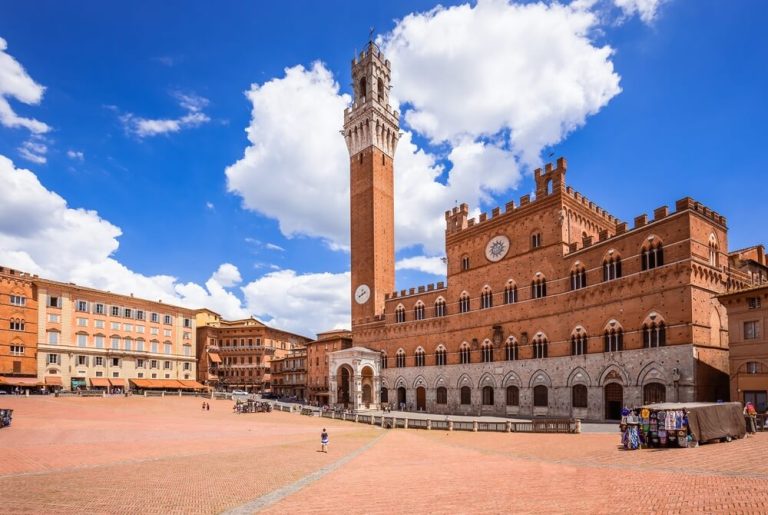
Pisa
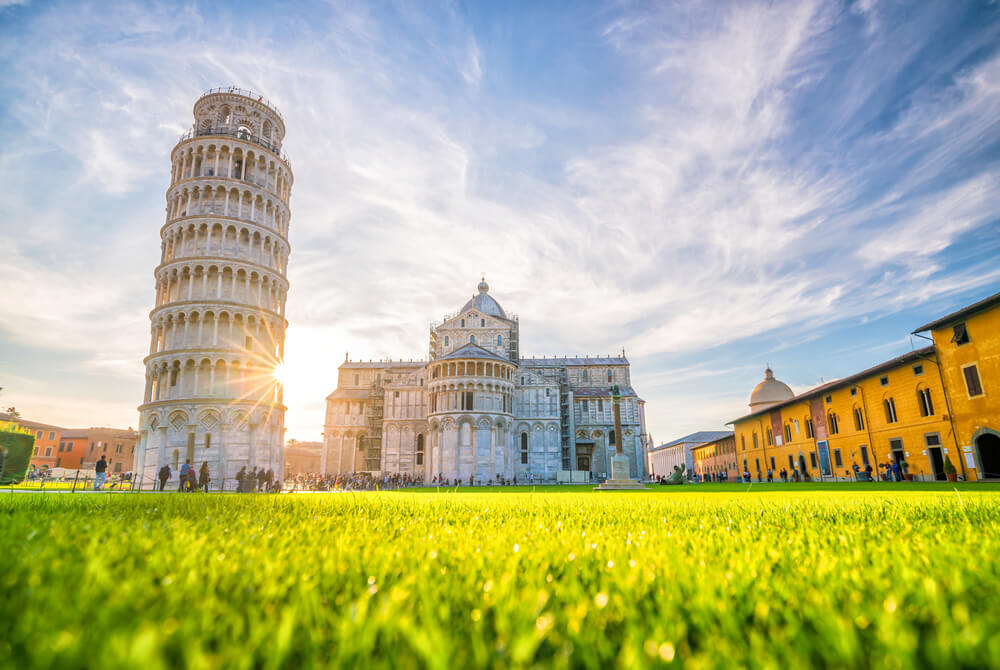
Introduction to Pisa
Pisa is known all of the world for its leaning tower! However, this is just one of the attractions in the Piazza dei Miracoli. The Cathedral and Baptistry are also found here as is the Camposanto, Sinopie Museum and the Opera del Duomo museum.
But visitors to Pisa should make the time to explore beyond Pisa’s most famous square. Discover the greener side of Pisa at the city’s Botanical Gardens. These were founded in the mid sixteenth century and can claim to be the first ever university botanical gardens anywhere in the world.
Or spend time in some of the museums in Pisa. As well as the Museo delle Sinopie, there is the Museo Nazionale degli Strumenti per il Calcolo and the Museo di storia naturale dell’Università di Pisa which is the city’s natural history museum. Also worth visiting is the Museo Nazionale di San Matteo which is on the banks of the River Arno. This is home to artworks dating back centuries and includes works by Giovanni and Nicolo Pisano, Simone Martini and Masaccio.
Or for a more modern take on art, head away from the river to the Piazza Vittorio Emanuele II. Here, on the walls of the Sant’ Antonio Abate church, there is his 1989 mural entitled Tuttomondo.
Use our guide to spending 48 hours in Pisa for more ideas on how to spend your time in Pisa.
Tips for navigating the city
Pisa is a small, easily walkable city. However, for when those legs do get weary, there is a local bus service. Alternatively, you can opt to get about on two wheels. Bike rentals are available at Pisa Centrale train station. Or there is a bike sharing scheme with stations throughout the city.
Like many Italian cities, the historic centre of Pisa is a Limited Traffic Zone (ZTL). Whilst residents and businesses may be able to enter by car, you are unlikely to be able to as a visitor. Instead, if coming by car, opt to park in the free park-and-ride on the Via Pietrasantina. Alternatively, there are free car parks on Via Pratale and on Via Paparelli. Both these are within walking distance of the historic centre. Or there is also paid car parking such as on Via Cammeo, Via Vecchia Barbaricina and at the Piazza Vittorio Emanuele.
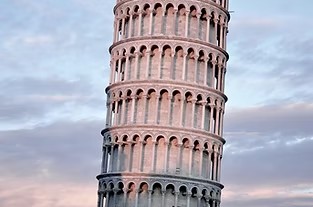
Rome
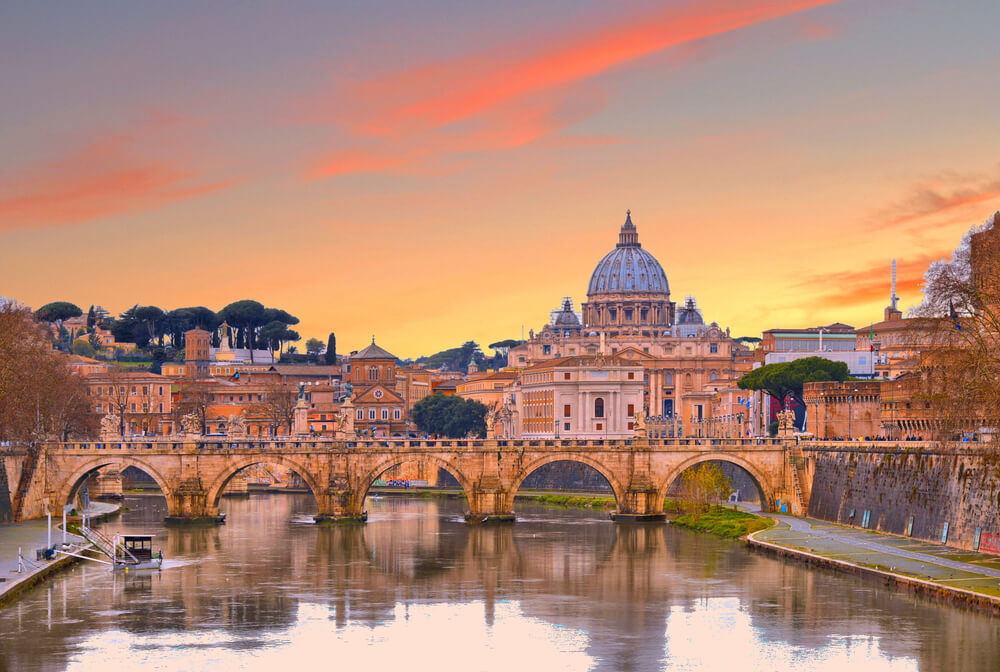
Introduction to Rome
It’s not a surprise that the nation’s capital – Rome – is also the most popular tourist destination in the country. Holidaymakers come to admire the city’s most iconic buildings and monuments. These include the Colosseum, Forum and Pantheon as well as the Trevi Fountain, Spanish Steps and Castel Sant’ Angelo. The city also attracts Christians from all over the world who visit the Vatican, the home of the Roman Catholic Church. Here, St Peter’s Square is an awe-inspiring sight. Close by, the Vatican Museums house some of the world’s most important art collections. With over 54 galleries and 70,000 art works, key attractions include the Sistine Chapel, Pinacoteca, Gallery of Maps and Raphael Rooms.
Discover how to spend 48 hours in Rome with Italy villa rental specialists Bookings For You.
Tips for navigating the city
Rome is easily walkable. However, it is a big city and you may well be surprised at how many miles you stack up walking from place to place within the city each day. It also has some pretty uncomfortable cobblestones in places so make sure you wear sensible, comfortable footwear!
However, for when walking gets too much, Rome has a varied, user friendly and relatively cheap public transport system. Since most public transport is also operated by a single company – ATAC SpA – it means it’s easy to switch between different modes of transport. The same tickets can be used on the metro, buses, urban trains and trams.
For a start, Rome has a metro system. Whilst it is not extensive, it does stop close to the main attractions. There are 3 metro lines: A (orange / red), B (blue), and C (green). It is lines A and B that cover the city centre. Most of the major sights in Rome are reasonably close to a station on one of these two lines. You can choose to buy a ticket for a single journey (100 minutes) or a ticket for 1, 2, 3 or 7 days. Tickets can be purchased at an ATM machine in the metro station, at a tobacconist or newspaper stand. Or you can now also use Tap&Go with a contactless payment card at the metro gate. Trains can go as frequently as every 2-3 minutes at peak time, but may be every 10 minutes during off peak hours.
If the metro is too limiting for you, then you have the option to take the bus instead. This is certainly a good option if heading to visit the Catacombs along the Appian Way. Buses tend to run from early morning until midnight. But, between these hours, there are also night buses. Look for the blue owl symbol to find them.
Rome also has six tram lines. These tend to be less helpful for tourists since they don’t reach the heart of the city. However, if you want to try this more traditional mode of travel, opt to hop on the number 19 which will take you to the Vatican.
If opting for a taxi in Rome, make sure you check the taximeter is switched on and only use a reputable licensed cab. Taxis can be found at taxi stands which are often located near the main tourist attractions.
Finally, if looking to escape the city, it’s worth using the urban train network – Ferrovie Urbane. These run daily from 5.30 until 10.30, with trains leaving every 10-20 minutes.
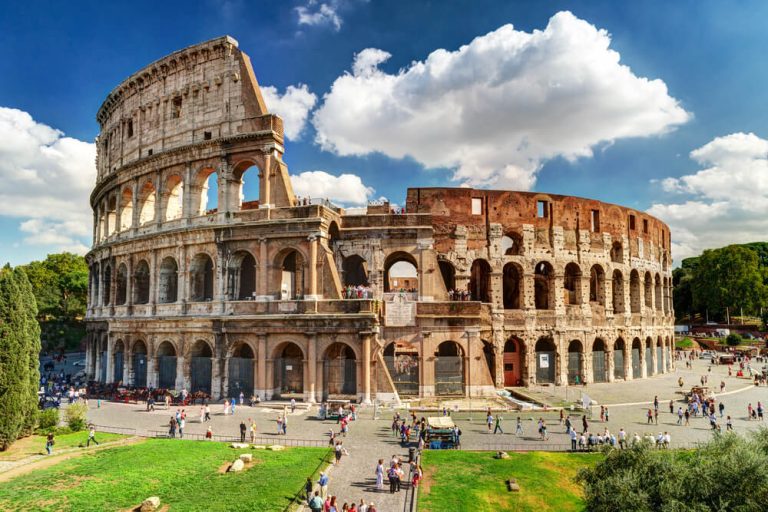
Venice
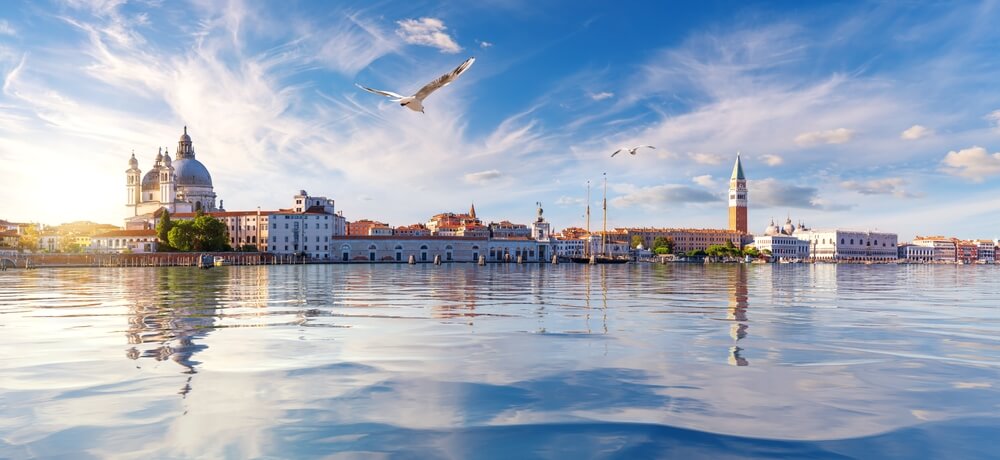
Introduction to Venice
Venice has to be one of the most picturesque cities in the world. The city is built on water and is made up of over 100 small islands, each connected by a network of canals and bridges. The largest canal is the Grand Canal. The Rialto Bridge crosses this and is one of the most iconic landmarks in Venice.
Venice’s most famous square is the Piazza San Marco. It’s home to St. Mark’s Basilica, the Doge’s Palace, the Campanile as well as the Procuratie Vecchie and Nuove, both of which house museums and exhibitions. Other notable attractions include domed Santa Maria della Salute which overlooks the Grand Canal.
Venice is also home to an incredible collection of art. At one end of the spectrum, at the Accademia Gallery, you will find works by Titian, Bellini and Tintoretto. At the other end, there is the Peggy Guggenheim Collection. This displays works by 20th century’s most influential artists, among them Picasso, Dali and Pollock.
And a short trip on the vaporetto will take you to the nearby islands of Murano (famous for its glass), Burano, and Torcello.
Tips for navigating the city
With so many canals, you won’t find any cars in Venice! Instead, you can easily navigate the city on foot or by boat. Walking is the best way to explore Venice’s six different neighbourhoods (sestieri). The city is actually quite small and the main sights are usually well signposted and easy to find.
However, of course, Venice is the home of the gondola and no visit to Venice would be complete without heading out on the water. Whilst a gondola ride can be pricey, it’s an experience to savour at least once in your life. Agree a price in advance with your gondolier.
There are other transport options open to you as well.
A cheap alternative to the gondola is the traghetto. Best described as a gondola ferry, visitors can hop on board at the docks at Santa Sofia, Riva del Carbon, San Toma, Santa Maria del Giglio and Punta della Dogana. At just a couple of euros, this is the cheapest way to cross the Grand Canal by boat.
Alternatively, the vaporetto service is a much larger water bus that operates throughout the city. It is operated by ACTV and is divided into four main categories. There are two city centre lines (lines 1 and 2) which head up and down the Grand Canal. Another connects Venice with the islands whilst a fourth connects Venice with the beaches of the Lido. Tickets aren’t cheap and last for 75 minutes once validated. You can also purchase 1, 2, 3 or 7 day Vaporetto passes for unlimited rides.
Private water taxis are also available. These come with a hefty price tag but they are an incredibly glamorous way to travel. These speedboats can accommodate up to 10 people so the price tag is less intimidating if you’re part of a larger group.
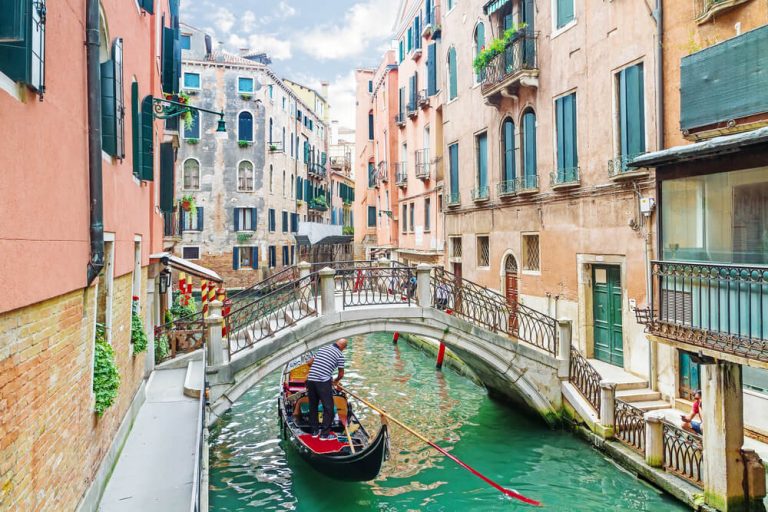
Milan
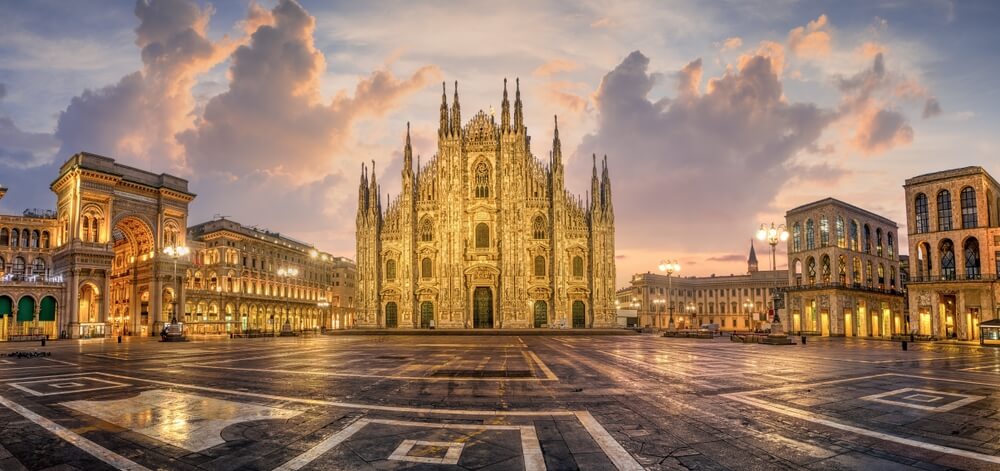
Introduction to Milan
Milan is Italy’s second most populous city and the country’s economic capital, home to Italy’s stock exchange. It is widely recognised as the global capital for design and fashion and is the second most visited city in Italy behind Rome.
It’s also a major cultural centre. It is home to iconic landmarks such as the Duomo and the Galleria Emanuele II, which, in our opinion, is the world’s most beautiful shopping centre. It’s also where you will find La Scala opera theatre and the Sforzesco Castle.
Its museums and churches house some of the world’s most famous paintings. For example, Leonardo da Vinci’s The Last Supper is kept in kept in the Convent of Santa Maria delle Grazie. And Milan’s Pinacoteca houses a superb collection of art, with works by Piero della Francesca, Raphael, Rubens, Rembrandt and Caravaggio. Works by 20th century artists such as Picasso and Kandinsky can be found in Milan’s Museo del Novecento.
Tips for navigating the city
Whilst Milan can be explored on foot, the city does have a super efficient transport system for when you need it.
The metro system in Milan is often the quickest way to get around. There are five different lines: M1 (red line), M2 (green line), M3 (yellow line), M4 (blue line) and M5 (lilac line) along with an additional 6 stops on the Milan Passante underground railway.
Above ground, trams and buses also provide a good variety of routes throughout Milan.
If you are in Milan for a few days, we recommend you purchase a Yes Milano City Pass. As well as giving you 3 days of unlimited travel on trams, buses and metro lines (zones M1-M3), it also provides access to a number of Milan’s top attractions, museums and landmarks.
Taxis are also readily available in Milan. And finally, there is also a public bike sharing system – BikeMi. Pick up and return bikes at any of the 325 designated stations around the city.
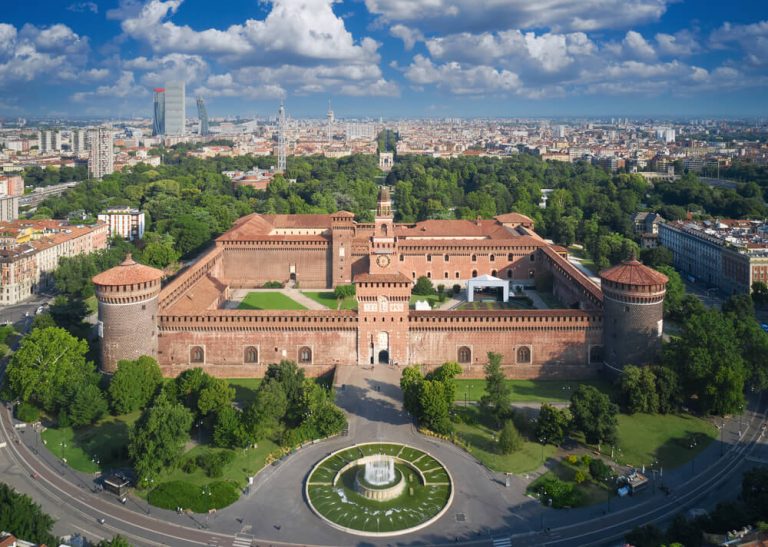
Bologna
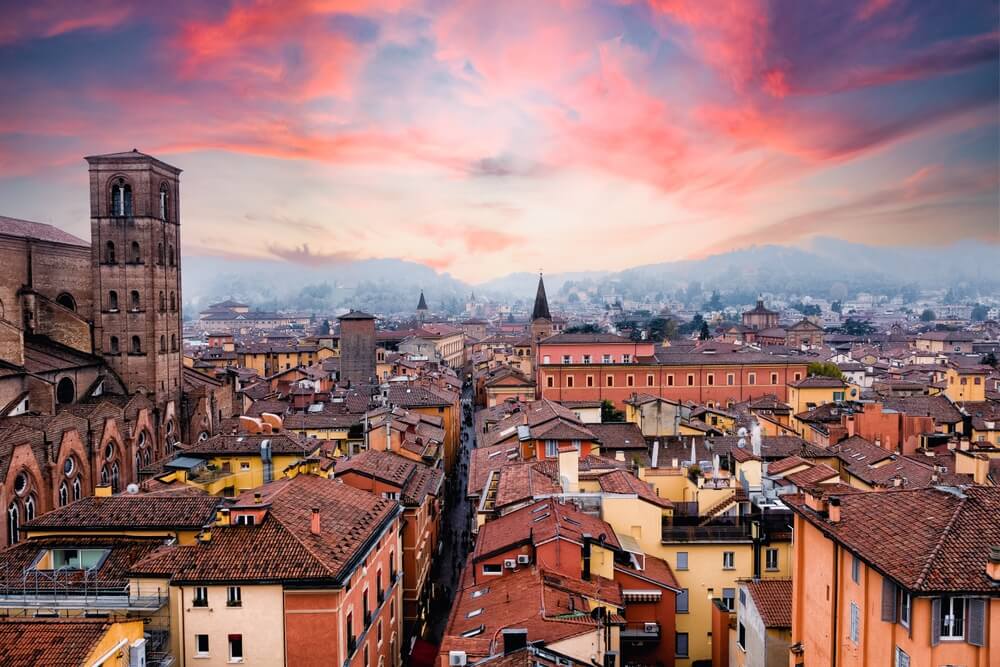
Introduction to Bologna
Bologna is the capital of the Emilia Romagna region in northern Italy. This is a mecca for food lovers. It is also home to the oldest university in the world. The 16th century Archiginnasio was the main building of the University. It can be visited today to marvel at the Teatro Anatomico which would once have been used for anatomy lectures.
Bologna is also home to not one, but two, leaning towers. The Due Torri are two Medieval towers. At 97.2 metres tall, the Torre degli Asinelli can actually claim to be the highest leaning Medieval tower in the world. The smaller Garisenda tower stands at just 48 metres tall, but it nevertheless has a rather noticeable lean!
Bologna’s central piazza is the Piazza Maggiore. It is home to the Basilica of San Petronio, the Palazzo dei Notai, the Palazzo d’Accursio, the Palazzo dei Banchi and the Palazzo del Podesta. And adjacent to the square is Bologna’s famous Neptune Fountain.
One of Bologna’s most famous landmarks is the San Luca monastery. This sits 4 km from the historic centre and looks down over the city below. To reach it, we recommend you walk the 4km uphill path from the city under the 666 arches of the Portico San Luca, the longest portico in the world.
However, if the uphill climb is too much, there is an easier option. Catch the San Luca Express tourist train instead.
Tips for navigating the city
If arriving in Bologna by plane, the easiest way to get into the city centre is via the Marconi Express. This connects the airport with the central train station in just 7 minutes. Trains leave every 4-8 minutes.
Once in the city centre, there is no underground system like in some Italian cities. But Bologna’s bus network provides good access to almost every corner of the city. Travellers can purchase a single ride ticket. This is valid for 75 minutes once validated or until you exit the bus it was validated on. Alternatively, if you are going to be using the bus a few tines, you can buy a 10 ticket carnet for a discounted rate or a day pass valid for 24 hours after validation. Monthly passes are also available. Single tickets can be purchased on the bus. These and all other tickets can also be purchased at ticket machines at Bologna airport, train and bus stations as well as in Tobacco shops and online via an app. Make sure you validate your ticket as soon as you board. Failure to do so could result in a hefty fine.
However, in reality, most of Bologna’s main sightseeing spots are in the historic centre. And this is easily accessible on foot. The only exception would be the Basilica di San Luca, situated on a hill nearby. However, we still recommend walking here if you can since it will allow you to experience a walk along the world’s longest portico.
You can also explore Bologna on two wheels by bike. The city has the RideMovi bike sharing service. Or you can opt to hire an electric scooter too.
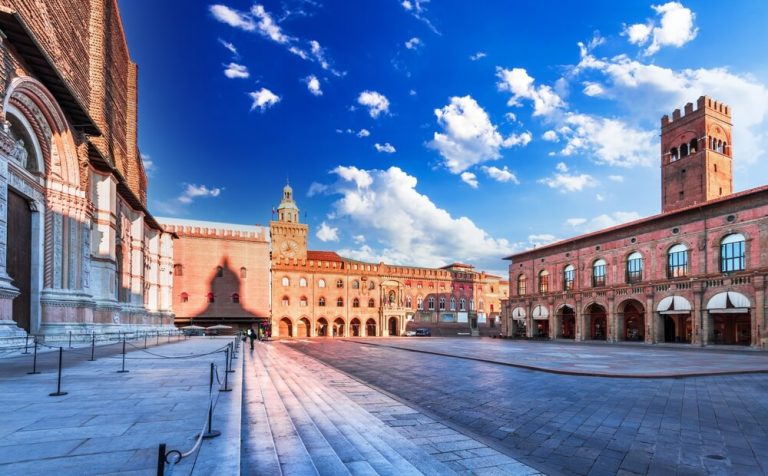
Bari
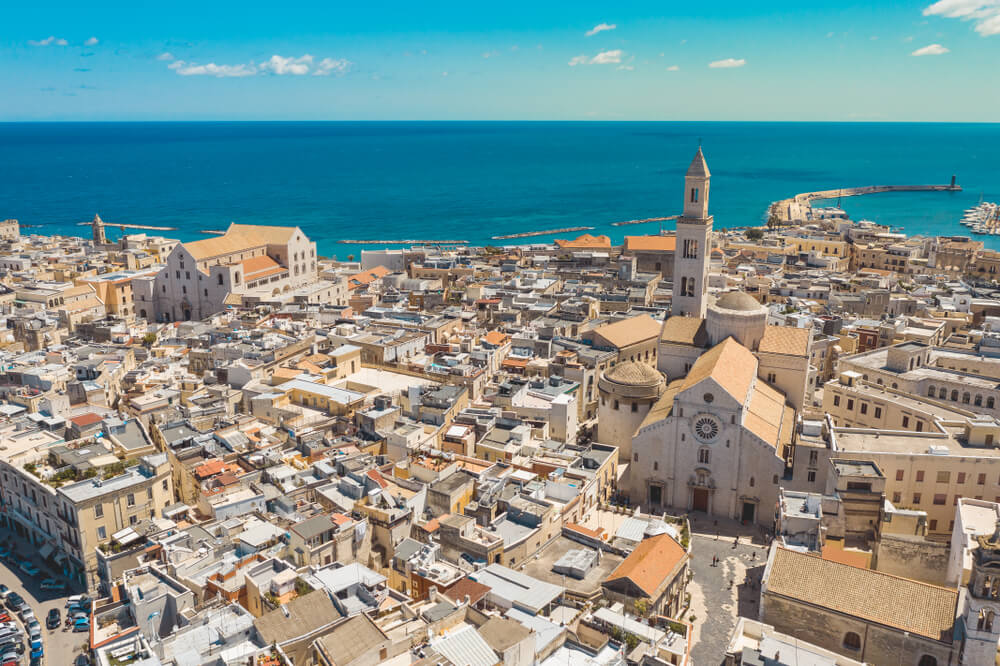
Introduction to Bari
Bari is the capital of the Puglia region in southern Italy. It has a relatively small old town which can easily be explored in 3-4 hours. But, to truly soak up the unique southern Italian vibe which is hidden in Bari’s maze of narrow streets and alleys, we recommend you stay longer.
Some of Bari’s main attractions include its 12th century Norman castle, nestled at the edge of the old town. It is surrounded by perfectly preserved gardens that were originally planted for Bari’s Duchess, Isabel of Aragon. Also of note are two of Bari’s churches. The first – Palazzo Simi – is actually now a museum. The second – the eleventh century Basilica di San Nicola (Saint Nicholas) – was built to house the relics of Saint Nicholas when they were stolen form Turkey. Its simple exterior gives no hint of the beautifully ornate walls and ceilings inside.
Puglia’s culinary heritage is wonderfully rich and there is nowhere better to experience it than among Bari’s ‘pasta ladies’. Sat in the street making pasta by hand, these ladies represent generations of women who have worked from their open kitchens in Bari Vecchia.
Tips for navigating the city
Like so many Italian cities, Bari has a ZTL (Zona Traffico Limitato) which cars can not enter without special permission. In fact, pretty much all of Bari Vecchia is a restricted area. As a result, Bari is definitely best explored on foot.
The second best option is then to explore by bike. There is an excellent network of cycle paths and lanes across the city. The bike sharing app VaiMoo allows visitors to pick up and drop off a bike from one of the 200 collection points in the city. Both e-bikes and traditional bikes are available.
If you do need to use public transport during your visit, then the bus network run by AMTAB is extensive. It has 33 lines that cover all of Bari’s districts. Tickets can be purchased for a single journey. However, if you are going to be in the city longer, there are also weekly and monthly passes.
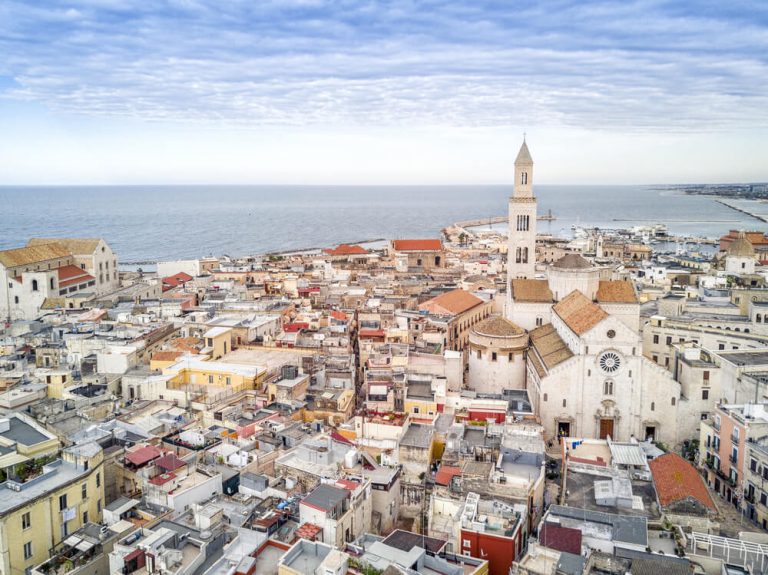
Naples
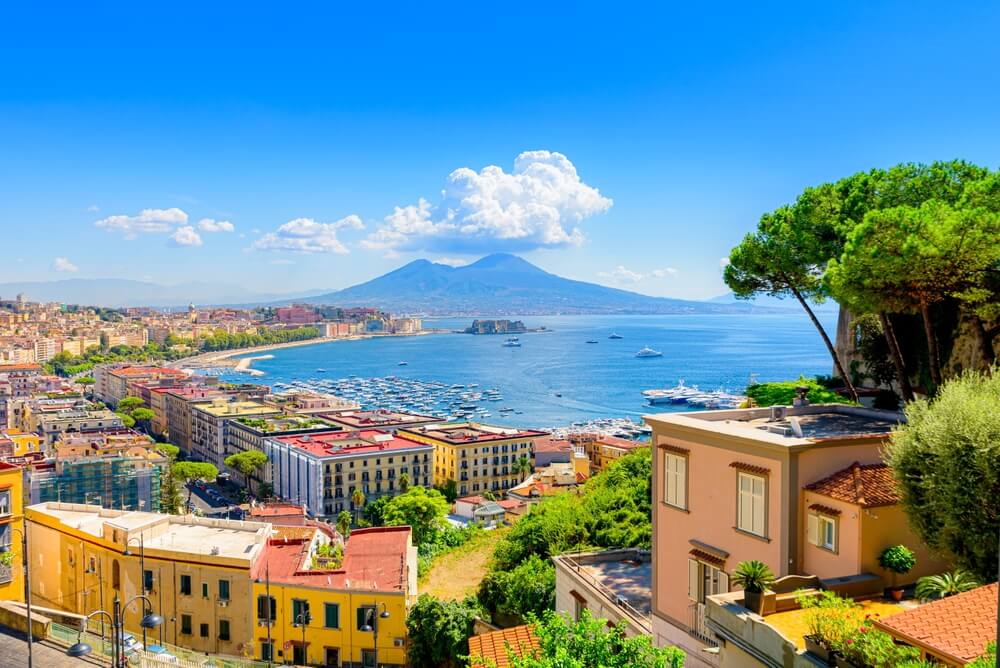
Introduction to Naples
Naples is the third largest city in Italy. Fun fact! It’s also the world’s oldest continuously inhabited city. But what piques our interest more is that it’s the birthplace of pizza!
There is plenty to see and do in Naples. Some of our favourite sites include the cathedral (Duomo), the Chapel of San Severo (to admire the statue of Cristo Velato carved from a single block of stone), the Galleria Umberto I shopping centre and the Via San Gregorio Armeno. This street is more affectionately referred to as the Via dei Presepi (street of the cribs).
Also worth a visit is the main square in Naples – the Piazza del Plebiscito – home to the Basilica of San Francesco di Paola and the Royal Palace. And definitely take the funicular from the Piazzo Montesanto to the star-shaped hilltop Castel Sant’ Elmo to enjoy the amazing views over the city, across to Mount Vesuvius and the Bay of Naples beyond.
There are plenty of museums in Naples too, from the Museum of Art (which includes works of art by Caravaggio, Titian and Raphael) to the MANN – the Museo Archeologico Nazionale di Napoli.
You can even explore underground in Napoli Sotterranea to discover centuries of history from the Greeks to the Romans and to the recent past of WWII. You can also head underground to discover the Catacombs of San Gennaro and the Bourbon Tunnel in the Via Domenico Morelli.
And Naples is a great base from which to enjoy day trips to the islands of Capri, Procida and Ischia, to the nearby Roman remains at Pompeii or to Mount Vesuvius.
Tips for navigating the city
Naples can easily be explored on foot. The main attractions in Naples are all near the sea front and the historical centre. As a result, 9 times out of 10, walking is the best option to get from A to B.
That said, Naples is a sprawling city so there are occasional times when using public transport can be helpful.
Naples does have a number of bus routes. However, we have to admit that we have found using the buses in Naples to be pretty frustrating. Traffic in the city is notoriously bad and there are few bus lanes to allow them to bypass traffic jams. As a result, buses don’t tend to be all that reliable with regards timings and journeys often take longer than they should.
Instead of the bus, you may want to consider the tram instead. They have the advantage of being on dedicated tracks and so can escape the traffic. However, on the flip side, the tram route is far less extensive than that of the buses and not many stop near the main tourist attractions.
Or, for a completely different form of transport, you can also take a ride on the funicular. This is used a lot by locals to go to and fro between the hilltop residential neighbourhoods and the city below. It runs daily from 7 am to 10 pm.
And, last but not least, Naples also has a metro system. Like the one in Rome, it’s not that big and so it is fairly easy to navigate. There are just 2 lines. The first is the one tourists tend to use most. It goes from Napoli Centrale to the northern suburbs of the city. This line also stops at the southern and western edges of the historic centre, at the Archaeological Museum, Duomo and the ferry terminal. The second line also stops at the ferry terminal as well as the northern edge of the historic centre near the Piazza Cavour. Trains run every 10 minutes or so from 6 am to 11 pm on this network.
Incidentally, the metro stations in Naples are almost a tourist attraction themselves. The Toledo metro station is just one of a number of stations designed by a contemporary artist and displaying beautiful works of art.
Whilst there are a lot of different public transport options, they all fall under the same ticketing system. As a result, you can use the same tickets on all of them. Tickets can be purchased at the tobacco store or at ATM machines at the metro station.
If you need to get a taxi, taxi ranks are easy to find and clearly marked. Official taxis are white in colour. Taxis should be metered but if it’s a short journey, don’t be surprised if the driver just rounds up the price! We recommend you check rates and negotiate a price before getting in the car and then make sure that the meter is running once in.
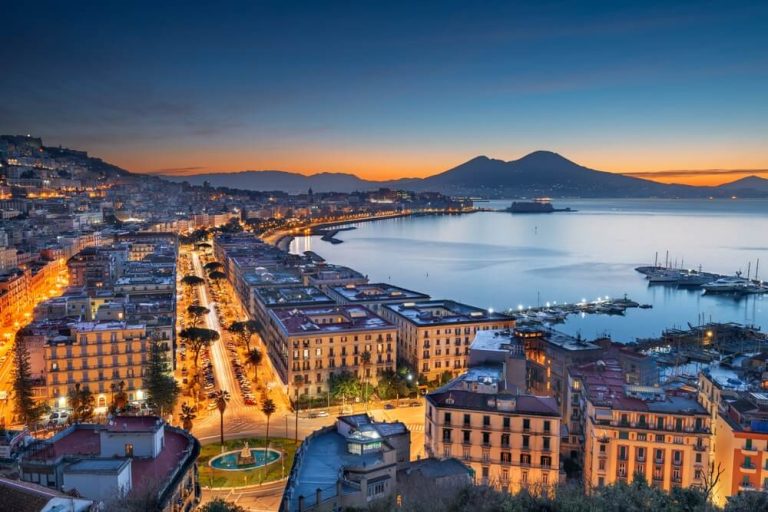
Turin
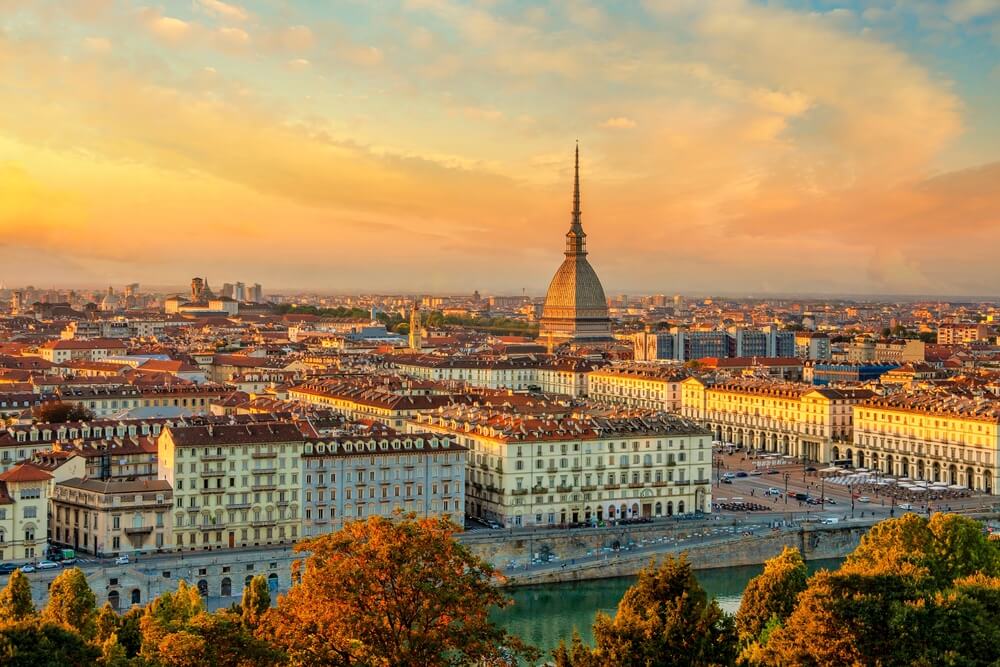
Introduction to Turin
Turin is the capital of Piedmont. It was actually once also the capital of Italy, albeit briefly, for four years between 1861 and 1965. It is also one of Italy’s richest cities and home to Italy’s successful automobile manufacturers – FIAT, Alfa Romeo and Lancia.
There are plenty of things to do in Turin. A must is a visit to the Mole Antonelliana. Turin’s most distinctive building, it is also the world’s tallest museum. You will find the National Cinema Museum inside which is a must for film fans. Those not interested in the movies should still head there to ride in the panoramic lift to the terrace at the top. The views from here over the city of Turin to the Alps beyond are spectacular.
There are plenty of other museums in Turin, including one all about the Egyptians and another about the automobile industry.
Also in Turin are the residences of the Royal House of Savoy which include the Palazzo Reale. Collectively these are one of Italy’s UNESCO World Heritage sites. Once official residences of the royal family, all have huge historical and artistic value.
But Turin is not just a city full of buildings. It has plenty of green spaces too. Relax in between seeing the sights at the Parco del Valentino.
Tips for navigating the city
Yet again, Turin is an Italian city easily explored on foot. Just bring sensible footwear to cope with the cobbles beneath your feet!
It’s not a huge city. And, even if it’s raining in Turin, there are approximately 18 km of porticoes which will protect you from the elements when exploring the city.
If you do need to find transport, we would suggest that you may want to hire a bike. Turin is a great city for cyclists with over 100 miles of cycle lanes. The city has an excellent bike sharing service and special tourist passes can be purchased to use it. Head to the Tourist Information Centre in the Piazza Castello to purchase one. Or there are a number of other bike, e-moped and e-scooter sharing services which don’t have fixed collection or drop off points. Find out more here.
If you are venturing further afield, then Turin does have an extensive bus and tram network which between them reaches every corner of the city. Services run daily from 5 am until midnight.
There is also an underground metro system. However, with only 1 line, it’s not always going to get you to where you need to be.

Palermo
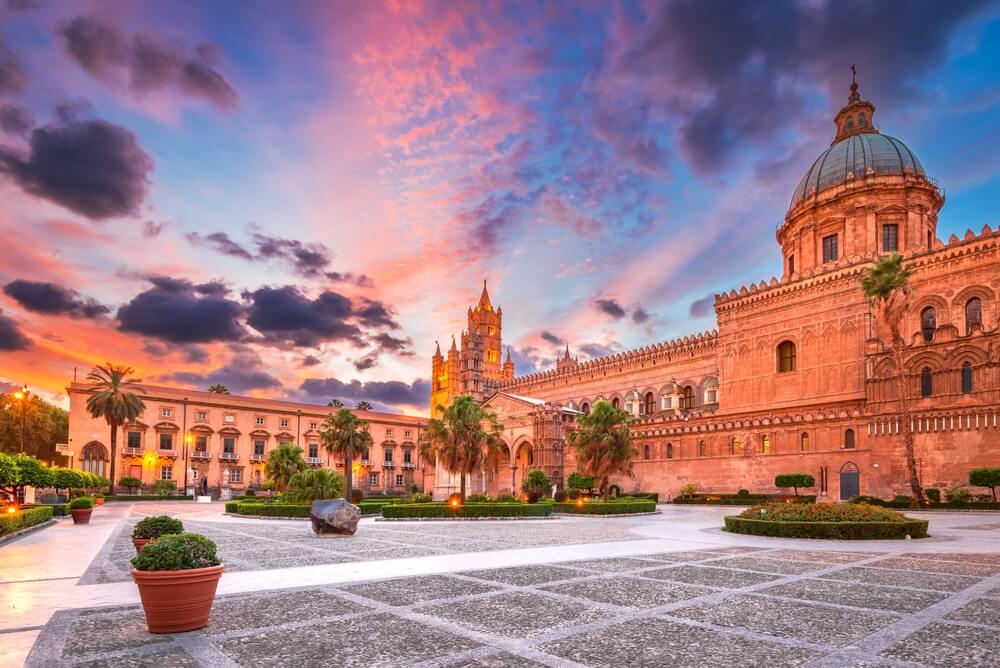
Introduction to Palermo
The capital of Sicily, Palermo is a city with a rich and extremely diverse history. A melting pot of cultures over the centuries, nowhere is this perhaps more apparent today than in some of its buildings.
Of note is the Palatine Chapel (Cappella Palatina) in the Palazzo dei Normanni. A spectacular sight, it was built as a royal chapel in the early twelfth century on the orders of Roger II of Sicily. Look closely and Greek, Arabic and Latin inscriptions are all obvious to see. Inside it contains extensive mosaic work and ornate carved wooden ceilings depicting scenes from everyday life. Palermo’s cathedral is a similar blend of architectural styles that span centuries.
Other churches of note in Palermo include the churches of San Giovanni degli Eeremiti and of Santa Maria dell’ Ammiraglio as well as the Chiesa del Gesu. Or for a rather more unsettling religious attraction, opt to visit the Capuchin Catacombs, home to thousands of mummified bodies.
As well as these historical landmarks, there are numerous others. To take just one more example, the Teatro Massimo, Italy’s largest opera house, is in Palermo.
But what we recommend most of all is to experience every day life in Palermo when you visit. Go to the local markets such as the Mercato di Ballaro or the Vucciria, where you can enjoy glimpses into local culture.
A visit to Palermo Archaeological Museum is also a huge must.
And make sure you take the time to just sit back and relax too. Mondello beach just 20 minutes outside the city is a great place to do so as is the Giardino Garibaldi in the heart of Palermo. Fun fact: this is where you can discover Europe’s largest tree.
Enjoy more inspiration in guide to the top 60 things to do in Palermo.
Tips for navigating the city
Your own two feet are often the best way for you to navigate Palermo. Distances between the major attractions in Palermo are entirely walkable. What is more, the heart of the city is a dense maze of streets and piazzas. There is a gem to be discovered around every corner. And walking ensures you’ll be in the right place and going at the right pace to discover them all.
If you do need a helping hand to get from A to B, Palermo does have a bus network operated by AMAT city buses. Running from 5.30 in the morning until 11 at night, it’s a cheap way to explore the heart of the city. Purchase your tickets at an AMAT machine or at a tabachi or edicole. And remember to validate your ticket on board.
Even better, AMAT actually have a couple of free bus services too. They’re marked gratis or navetta gratuita and run every 11 minutes or so through the main historic centre. The first connects the Porta Felice with the Kalsa district, Cathedral area and Via Cavour. The second connects the Basile parking area to the Piazza Indipendenza.
There is also a tram service in Palermo. Again run by AMAT, there are 4 different lines.
And there is a subway system. Here lines, A, B and C provide an alternative mode of travel in Palermo. However, many of the main tourist attractions aren’t covered on the subway route.
There are also the usual e-scooter and e-bike stations dotted around the city too. Or AMAT also operate a car and bike sharing system – AmiGo.
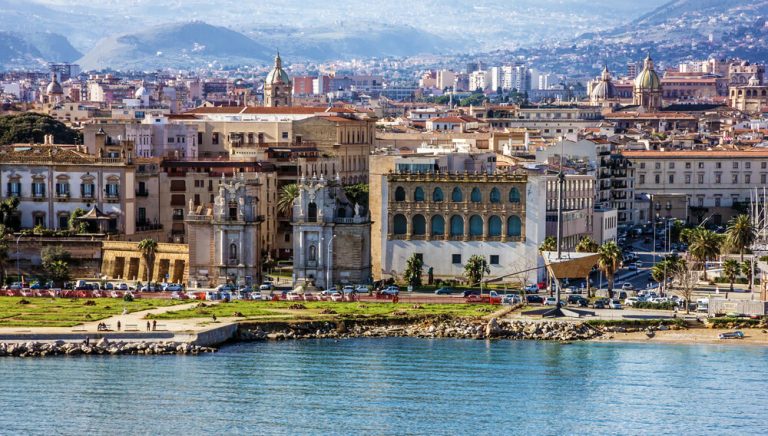
Genoa
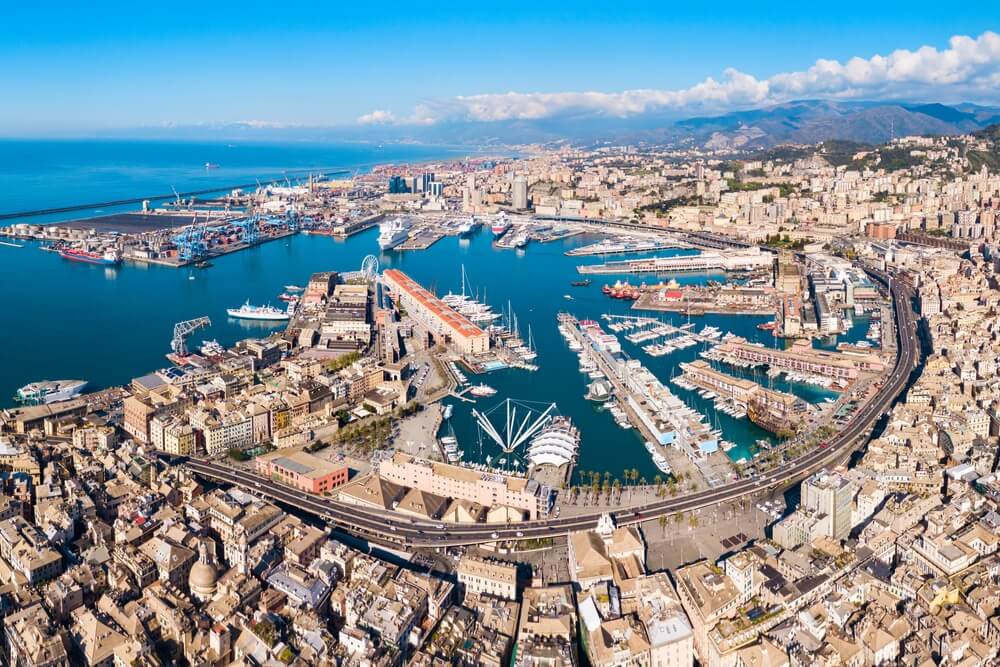
Introduction to Genoa
Referred to as Genova in Italy, Genoa is. quintessentially Italian city. An important maritime power in its heyday, it was also the birthplace of Christopher Colombus.
We recommend you start your visit in the Porto Antico (Old Harbour). This area of the city has seen much regeneration over recent years and is now a superb area lined with restaurants and bars. The La Lanterna lighthouse overlooks the harbour At 76 metres tall, it is one of the world’s oldest functional lighthouses. Purchase Genoa lighthouse tickets for entry to the building itself as well as to the scenic 800 metre long walking track that enjoys stunning views over the harbour.
More impressive than the lighthouse though is Genoa’s thirteenth century Doge’s Palace. What you see today is an amalgamation of Baroque, Renaissance and Gothic styles.
More palaces line the Via Giuseppe Garibaldi. This 250m long street is one of Italy’s UNESCO World Heritage Sites.
Other notable landmarks in Genoa include the Piazza De Ferrari and the San Lorenzo Cathedral.
Discover more in our Genoa travel guide.
Tips for navigating the city
Genoa has an excellent public transport system run by AMT. A combination of buses, boats, a subway system, lifts, funiculars and railways will help visitors to get from A to B.
There are over 140 bus lines and and 1 underground line which has 7 stations that provide immediate access to one of Genoa’s tourist sites. Two funiculars as well as 10 lifts take visitors from the lower to higher ground, connecting the heart of Genoa with the hills around the city where there are some fabulous viewpoints. There is also a historic rack railway dating back to 1901 which takes passengers from Piazza Principe to the Granarolo neighbourhood. And there is another narrow-gauge railway going from Genova to the village of Casella. Finally, a bus connects Pegli in Western Genoa to the city centre at Porto Antico in just 30 minutes.
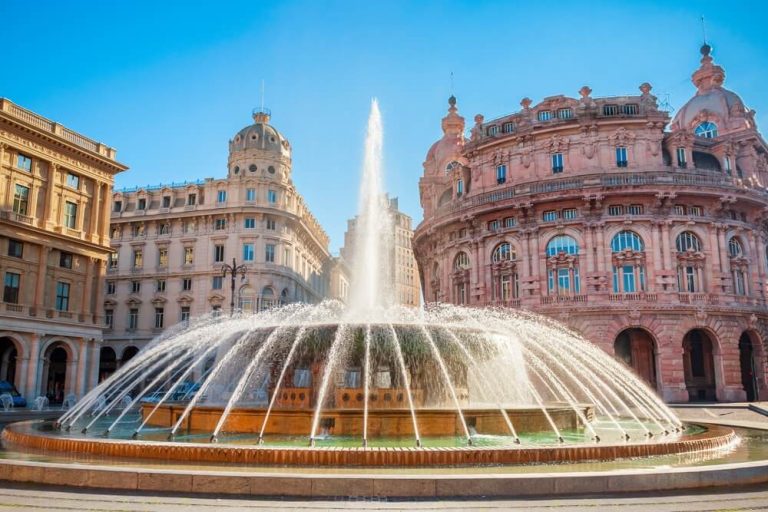
Other regions you might be interested in
Things to do in Italy
With approximately 65 million tourists visiting in 2024, Italy was the 5th most visited country in the world. Over the past decade the country has consistently been in the top 5 most visited countries. And perhaps it’s not surprising that we have so many clients choosing to holiday in an Italy villa when you consider all the things to do in Italy.
Art and Architecture
The history of Italy is extremely long with evidence that it stretches far back into pre-history to the time of the Copper Age. But probably its most famous periods include the time of the Romans and then the Renaissance period. This was a movement which began in Florence in the fourteenth century but which quickly spread to Siena, down to Rome and as far North as Milan and Venice.
The wonderful thing is that so much of this history has been preserved. From the Colosseum and Pantheon in Rome to the Ponte Vecchio, Palazzo Vecchio and Duomo in Florence, an incredible amount of Italian history is still wonderfully in tact for all to see and admire.
Much of this history is certainly retained in Italy’s buildings. From the Duomo of Milan to the Leaning Tower of Pisa to the Valley of the Temples in Sicily… The list of historic sites and beautiful buildings in Italy is endless.
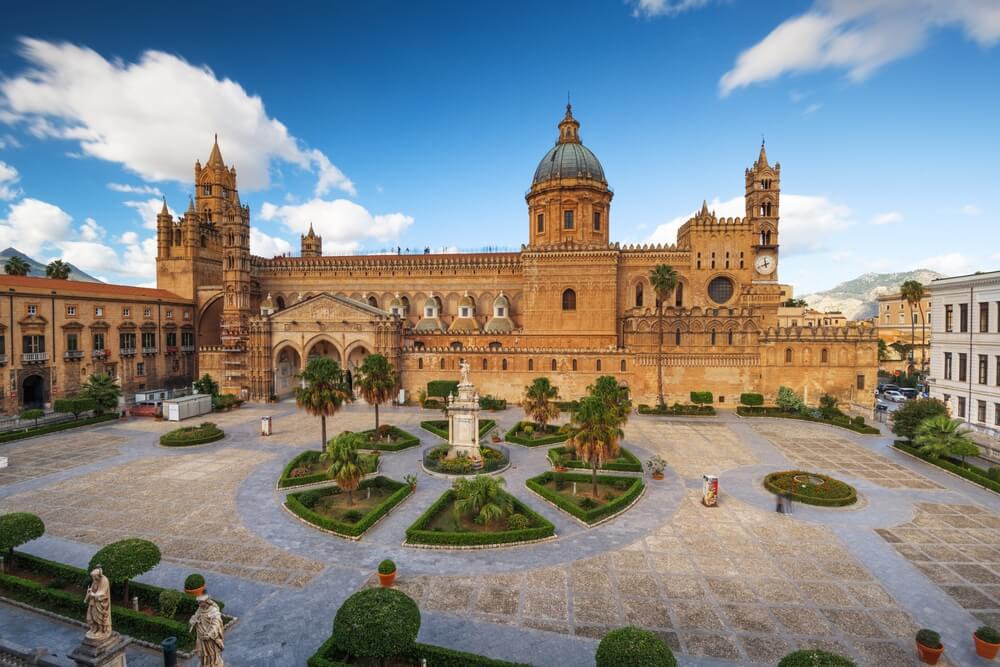
Italy’s rich history is also captured in its art. Italy is a veritable treasure trove when it comes to artworks. From Boticelli’s ‘Birth of Venus’ in the Uffizi in Florence to Leonardo’s ‘The Last Supper’ in Milan, gallery after gallery in Italy displays works by some of the world’s most famous artists. From the Sistene Chapel in the Vatican City to Michelangelo’s statue of ‘David’ in the Galleria dell’ Accademia, Italy really is oozing with an incredible array of world famous art.
However, you don’t have to visit important national galleries in Italy to see the wonderful art the country has on offer. The smallest hilltop village in Umbria can be home to a church housing works by some of the most renowned Renaissance artists. Head to the nearby church in the local town or village in which you are staying on your Italy villa holiday and you can come across breath-taking frescoes, artworks and sculptures.
Vineyards and wineries
Italy is one of the world’s oldest wine producers. Research has shown that the origins of vine-growing and wine-making in Italy stretch back even before the Phoenicians, Etruscans and Greeks who settled here. And it certainly goes back well beyond the Romans, albeit we have the Romans to thank for the increase in viticulture in the country.
Today, Italy is the biggest wine producer in the world. With every region of Italy producing wine, over 1.7 million acres of Italy are currently under vineyard cultivation. Some of the biggest wine regions include Veneto, Puglia, Tuscany and Piedmont. Much of the wine is exported around the world but Italians do like a tipple too, consuming an average of 42 litres per head per year. Cin cin!
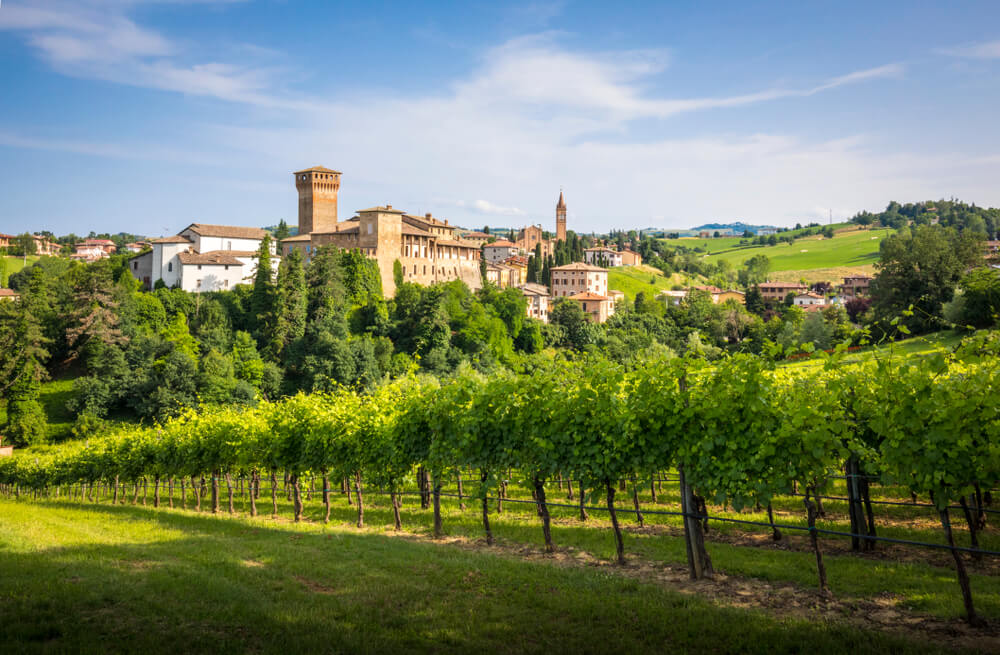
Tuscany is synonymous with wine thanks to the production of both Chianti and Chianti Classico wines. However, further north, Piedmont is renowned for its Barolo and Barbaresco wines. And Veneto is famous for the full bodied Amarone as well as the white sparking Prosecco. And in the south, you have the Nero d’Avola of Sicily and the Primitivo of Puglia.
Exploring the Italian countryside
Equally, no visit to Italy would be complete without exploring the breathtaking Italian countryside. Whilst Italian towns and cities have so much to offer, holidaymakers can’t fully appreciate Italy’s beauty until you have driven along its rural roads and visited some of its smaller towns and villages.
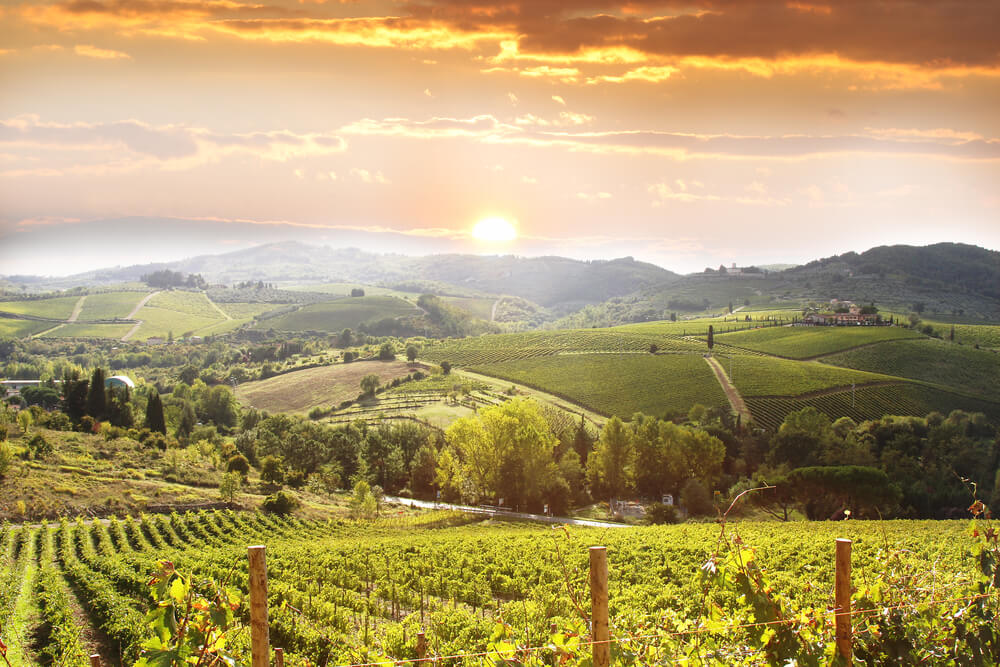
Italy is an incredibly varied country when it comes to its rich rural tapestry. In the north there are the mountainous regions of the Dolomites and the Alps. As you move south, there are then the gently rolling hills of Italy’s central belt. This is around Italy’s ‘green heart’ in Umbria and in the vineyards of Tuscany. Head south again and you will reach the lemon groves of the Amalfi Coast before reaching the olive groves of Puglia in Italy’s heel. Each region has a unique character, but each is as stunning as the next.
Food
The food of Italy needs no introduction. The home of pizza and pasta, Italy is synonymous with good food. Whilst the UK have only more recently started appreciating the value of ‘zero mile’ food, Italians have never veered from this approach. Italian food is not usually complicated. In fact, it can be remarkably simple. But the quality of the ingredients is second to none hence it always tastes incredible! Not only that though, Italians love and appreciate what they eat, where it is from and how it was made, and so they always take their time to enjoy their food. There is no rushing at the meal table. Instead, it’s a slow affair that ensures they can enjoy the company of those they’re dining with.
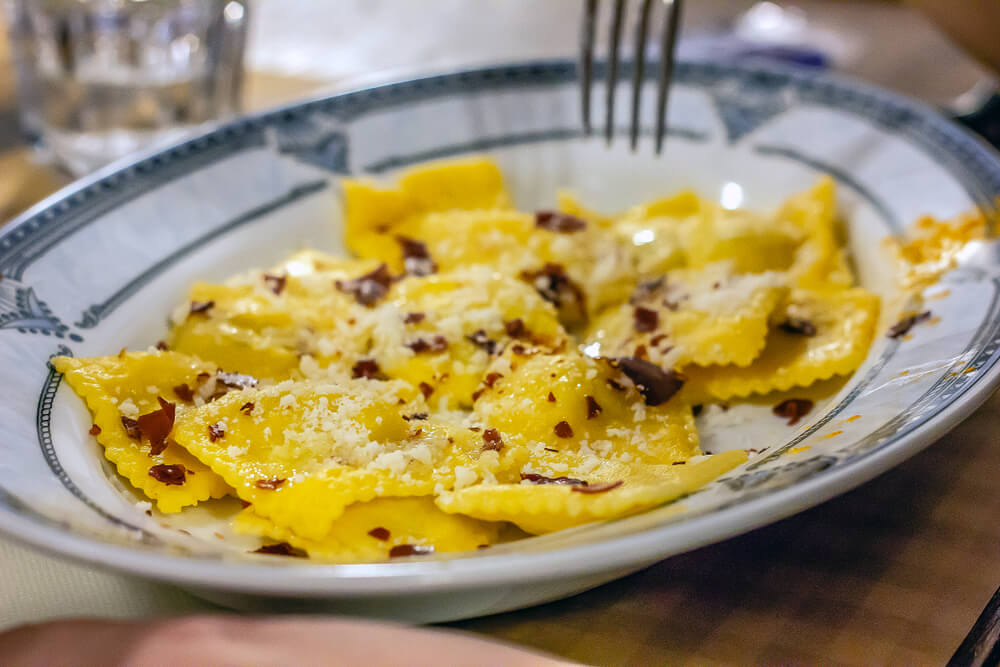
Each region of Italy will have its own culinary specialities that have been handed down from generation to generation. The north of Italy is known for warm, hearty dishes like polenta, risotto and Osso Buco as well as its cheeses and cured meats. In Central Italy, there are some classic pasta dishes – Cacio e Pepe and Carbonara – for example as well as other regional favourites. And in the south, there is a mix of pasta, seafood and vegetables. In Puglia, visitors must sample the Orecchiette pasta whilst in Sicily we recommend the Arancini.
Italian Beaches
With over 4,700 miles of coastline, Italy has a plethora of beautiful beaches to enjoy. With such an extensive coastline, and with each region of Italy having its own unique charm and appeal, Italy is certainly a great destination for beach lovers.
If you’re seeking white sand and Caribbean-like seas, then head to Sardinia. Here the beaches are among the most beautiful of any in Europe with powdery, white sand and crystal clear waters. If you’re after small rocky coves but in the most dramatic of settings, you may want to opt for the Amalfi Coast or the Cinque Terre in Liguria. Or if you’re after a chic, upmarket resort, perhaps head to the beach resorts of northern Tuscany such as Forte dei Marmi.
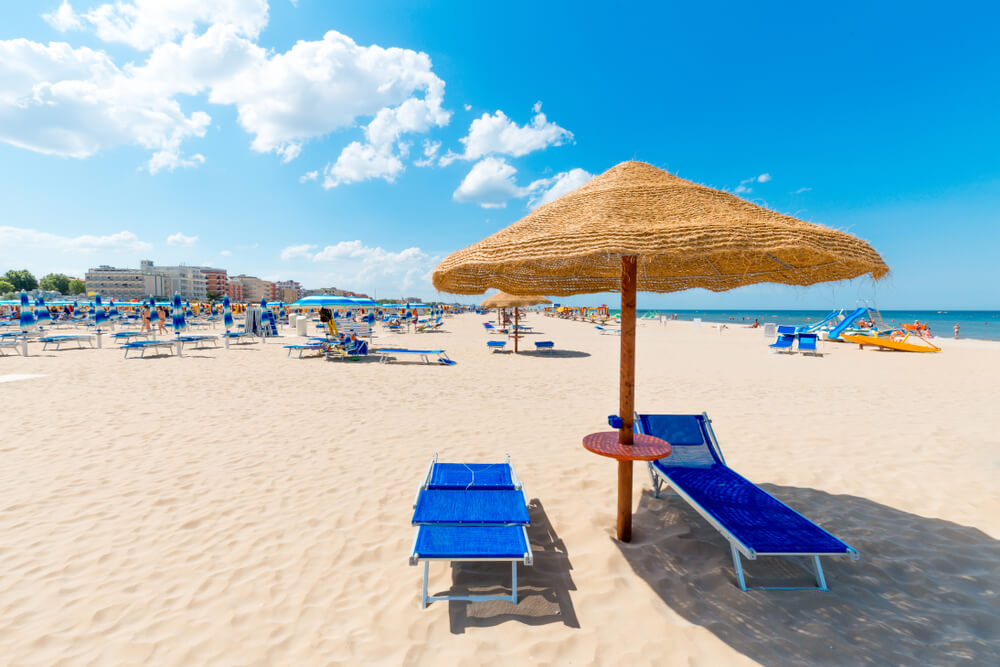
Some of the most striking include the beach at the base of the rocky white steps that make up the Scala dei Turchi in Sicily, the Cala Goloritzé in Sardinia and the beach at Marasusa in Calabria. Some of the most picturesque include the beach at Chiaia di Luna on the island of Ponza and the Cala di Volpe in Sardinia. Also in Sardinia, La Pelosa is one of our favourites when it comes to enjoying a dip in the sea. In fact, so good are the beaches in Italy that one in Puglia has even earned itself the nickname of the ‘Maldives of Italy’ thanks to its long stretches of pale white sand.
You’ll find Italy’s beaches busiest in July and August. This is the time for both peak temperatures and peak visitor numbers. Public beaches in Italy are free to use. However, holidaymakers will quickly discover that many are managed by private beach clubs (lidos). These require payment to use but do come with plenty of added extras including sun loungers, parasols, showers and WCs. Some also have bars and cafes serving food and drinks to an additional charge. Also be aware that some of the most enchanting beaches and coves in Italy can only be accessed by boat from the sea.
Italian Music
Opera is synonymous with Italy in the same way as art is. Some of the greatest opera singers the world has ever seen have been Italians – Caruso, Pavarotti and more recently, Bocelli. And these days, Italy encourages and appreciates all genres of music. There are a plethora of music festivals to enjoy from Umbria Jazz to the Ravello classical music festival and from the Verona opera season to the longstanding Sanremo Music Festival (which served as the inspiration to the European Song Contest). Whether your preferred genre is rock, pop, classical, rhythm and blues, jazz, hip hop or soul, all across Italy there are music festivals to suit all tastes and encompassing all genres.
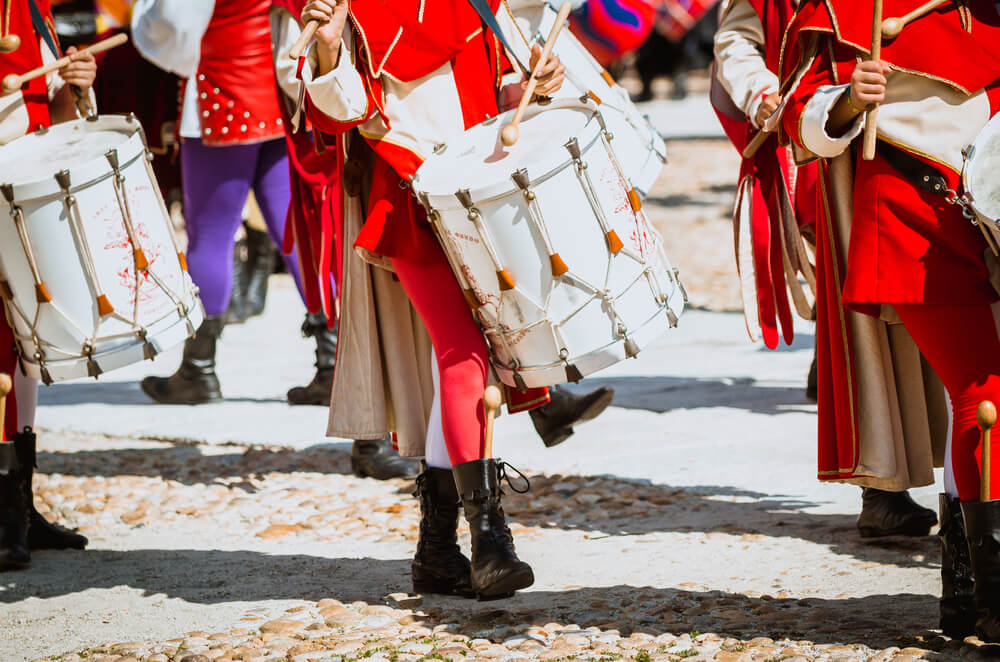
And music is incorporated into so many of Italy’s annual festivals too. Historic processions are often accompanied with music, reflecting deep cultural traditions.
Not only that. Italy is also home to some of the world’s most renowned orchestras and opera houses which showcase the country’s commitment to music. The Arena di Verona and the Teatro alla Scala in Milan are just a couple of examples with rank among the most inspiring and prestigious music venues anywhere in the world.
Best Places to Visit in Italy
We would argue that some of the best places to visit in Italy are those less well known corners and hidden gems. However, we totally understand that there are also a number of bucket list sights that simply have to be ticked off for you to have fully experienced Italy. For us, these attractions are those bucket list places to visit in Italy.
Basilica di San Francesco in Assisi
Assisi in Umbria is of Italy’s many UNESCO World Heritage sites. This Medieval hilltop town was the birthplace of Saint Francis. And it is where you will find the enormous Basilica di San Francesco. This is a beautiful church built on two levels. It houses the tomb of St Francis in its crypt. The church also brought together works by the greatest Florentine and Sienese artists – Cimabue, Giotto, Lorenzeti and Simone Martini.
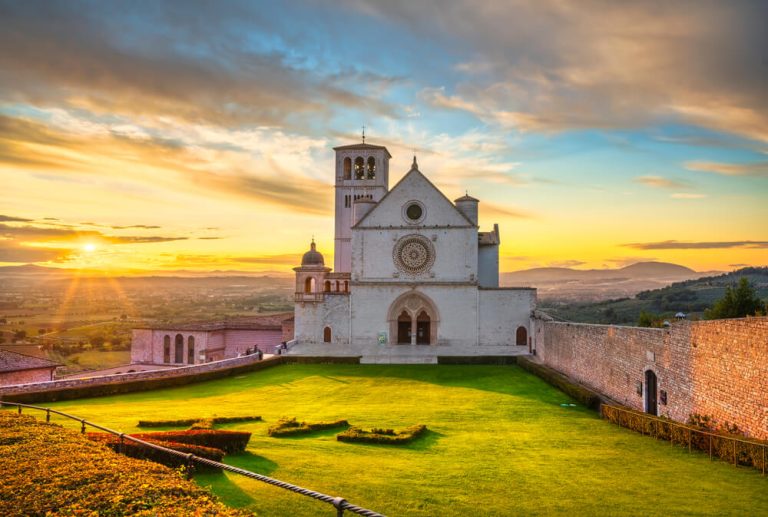
Pitti Palace in Florence
The Pitti Palace (Palazzo Pitti) was once the home of the Medici family. Later, it was also the court for the Houses of Habsburg-Lorraine and Savoy. The palace is divided into four museums and contains works by Titian, Tintoretto and Botticelli Skip the entrance queues by opting for skip the line entrance tickets to the Pitti Palace. The palazzo sits within the equally beautiful Boboli gardens, perfect example of a Renaissance garden.
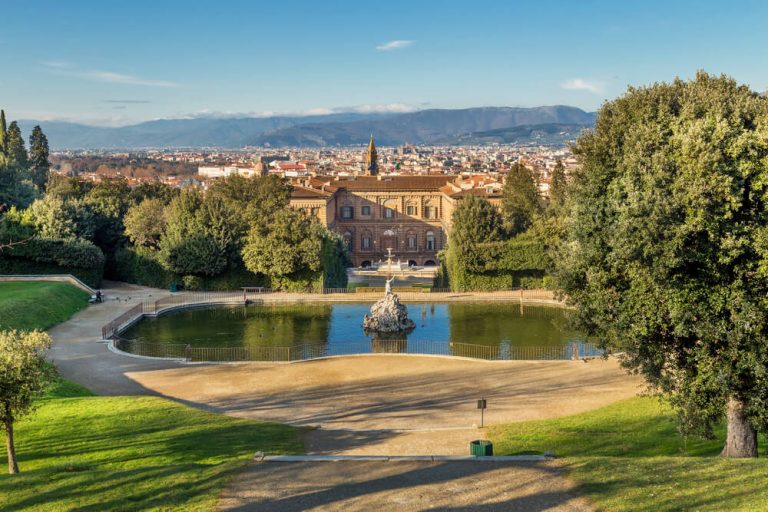
Piazza del Campo in Siena
The Piazza del Campo is Siena’s iconic central square. Shaped like a shell, red bricks slope gently under your feet whilst town houses and public buildings line each side. It is home to the Palazzo Pubblico as well as the 102 metre tall Torre del Mangia. We highly recommend braving the 400 steps to the top of this tower to enjoy the breathtaking views over the city. It’s also the setting for the Siena palio which takes place here twice a year. Enjoying an aperitivo in one of the cafes here should be on anyone’s Italian bucket list.
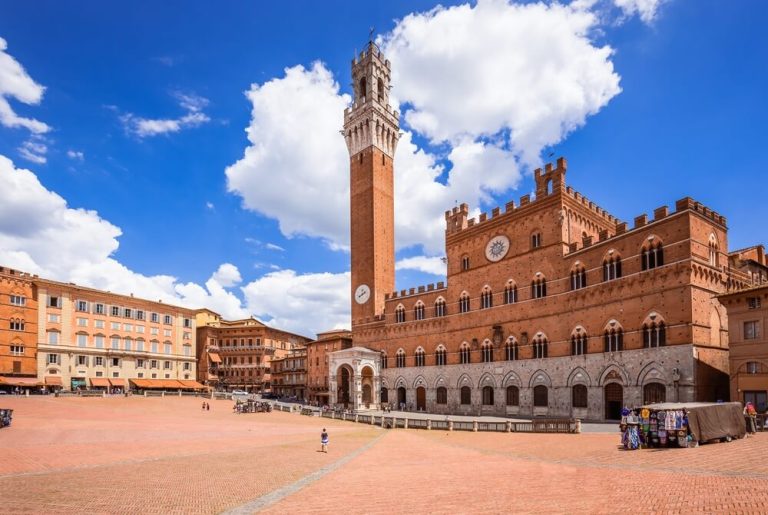
Orvieto Cathedral
Orvieto’s Gothic cathedral is truly breath-taking. Its facade is decorated with a series of mosaics. These tell the story of the Virgin Mary taking various scenes from her life including the nativity, presentation of Mary in the temple and assumption into heaven. Also of note, high in the centre of the facade, is the beautiful Rose Window by Andrea di Cione. Inside the Orvieto Duomo, there are beautiful frescoes by Luca Signorelli depicting the Last Judgement as well as the statue of Pietà by Ippolito Scalza. Incredibly, this was created from a single block of marble.
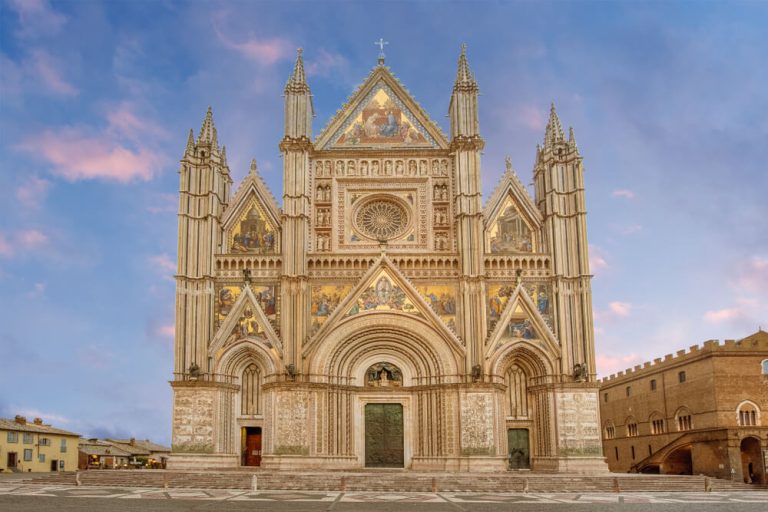
Two Towers in Bologna
Pisa may be famous for its leaning tower, but it’s not the only Italian city to boast a tower that leans! In fact, Bologna has not one but two of them! The Due Torri are two Medieval towers in the heart of the city. The Torre degli Asinelli is the tallest of the two at over 97 metres high. It can actually claim to be the highest leaning Medieval tower in the world. The smaller of the two towers is the Garisenda tower. Just under half as tall as its neighbour, it nevertheless still has a rather noticeable lean!
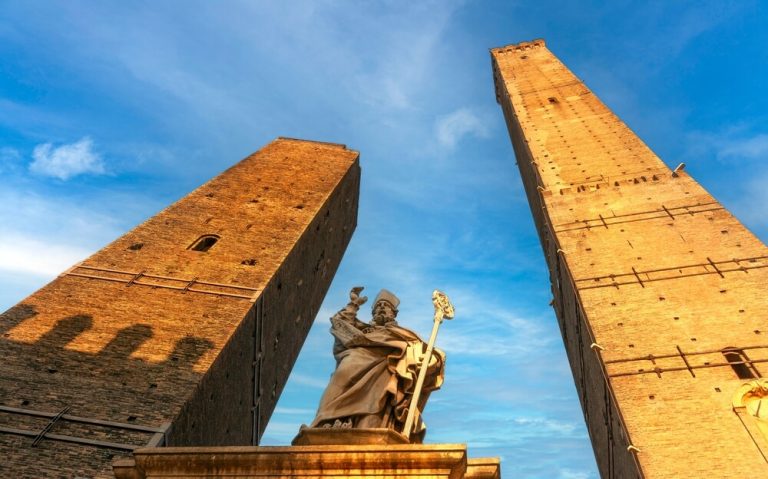
Colosseum in Rome
The Colosseum in Rome is the largest ancient amphitheatre ever built. Completed in 80 AD, it took thousands of slaves eight years to build. Seating up to 50,000 spectators, everything from gladiatorial battles to animal hunts and even naval battles would have been staged here. It stopped being used for entertainment in the early medieval era, but in the centuries that followed was used as a fortress, workshop and even a quarry. Today it is one of the most popular tourist attractions in the world with over 6 million visitors passing through its doors each year. Book ‘skip the line’ tickets to the Colosseum in advance to avoid the queues.
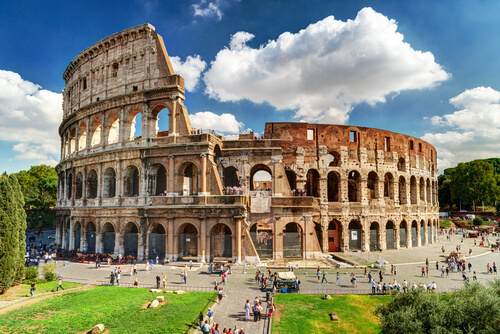
The Uffizi Gallery in Florence
Whilst Florence is home to an impressive 72 museums, its most famous museum is arguably the Uffizi Gallery. The building was designed by Giorgio Vasari and commissioned by Cosimo I de Medici. It is home to hundreds of incredible works of art dating back from the 12th to the 17th centuries. These include works by Titian, Leonardo da Vinci, Rubens, Michelangelo and Boticelli.
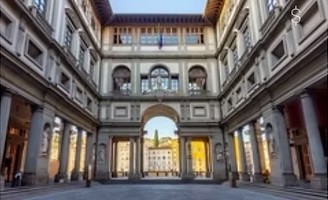
The Leaning Tower of Pisa
There is much more to Pisa in the Piazza dei Miracoli than just the leaning tower. But, there is no disputing that it’s this that draws the crowds year after year. The bell tower of the adjacent cathedral, just under 300 steps will take you to the top where you can enjoy the wonderful views over the nearby cathedral and baptistery.

Rialto Bridge in Venice
Straddling the Grand Canal, the Rialto Bridge is one of the most beloved and iconic landmarks in Venice. Constructed between 1588 and 1591, renowned architect Antonio da Ponte was commissioned to design and build it. He used Istrian stone for the construction, a type of warm, golden limestone. The bridge measures 75 feet wide and 90 feet long. It stands on two rows of shops that sell everything from souvenirs to jewellery to fresh seafood.
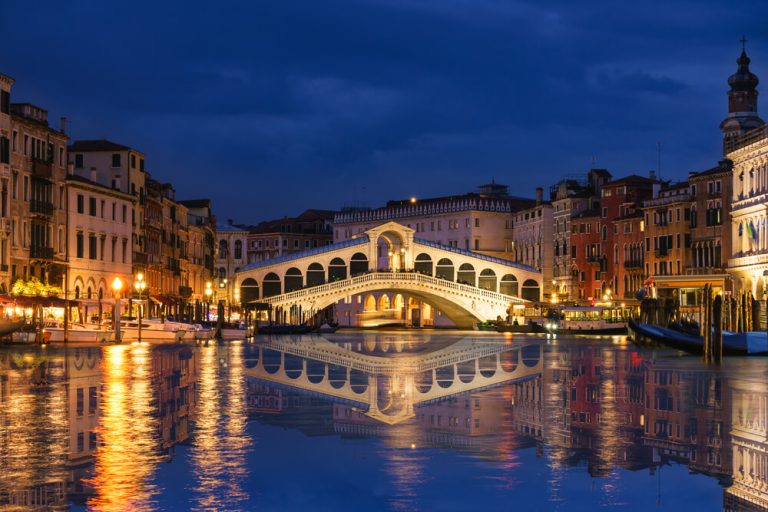
Duomo in Florence
The Cathedral of Santa Maria del Fiore and Brunelleschi’s dome, dominates the skyline in Florence. Measuring 153 metres long, 90 metres wide and 90 metres high, it is the third biggest cathedral in the world. Only St Peter’s in Rome and St Paul’s in London are bigger. We recommend that those without a fear of heights climb the 463 steps to the top of the dome. The views over the city from the top are spectacular. Alternatively, opt to enjoy an aerial view of the dome itself by climbing the 414 steps of the neighbouring Campanile.
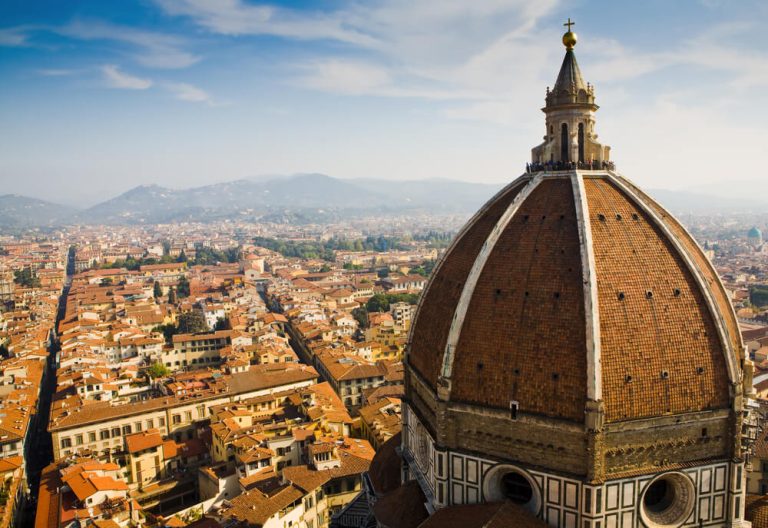
Pompeii
Pompeii is a fascinating historical site. Once a thriving Roman city, it was buried under ash when nearby Mount Vesuvius erupted in 79 AD. Today, it offers visitors a glimpse into life 2000 years ago. Pompeii’s best preserved sites include the Forum, Teatro Grande, the Amphitheatre, Temple of Apollo and Villa of the Mysteries. Also of note in the city are Pompeii’s Stabian Baths, the House of the Faun and the Lupanar, an ancient brothel.
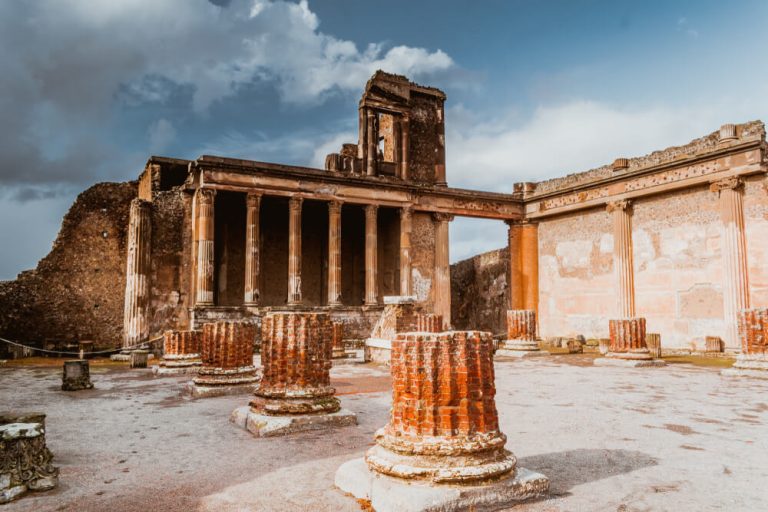
Pantheon in Rome
Dating back to 120 AD, the Pantheon is arguably the best surviving Roman monument anywhere in the world. Once an ancient Roman temple dedicated to all the gods, it was transformed into a church in 609 AD. These days it is a Catholic Church whose official name is the Basilica Santa Maria ad Martyres. Despite being built a couple of thousand years ago, its dome is still the largest unsupported dome in the world. It measures over 43 metres in diameter and has a large hole in the ceiling (oculus). This provides the only source of light (and also lets in the rain too!) These days, the Pantheon is also home to the tombs of both Raphael and of several Italian Kings and poets.
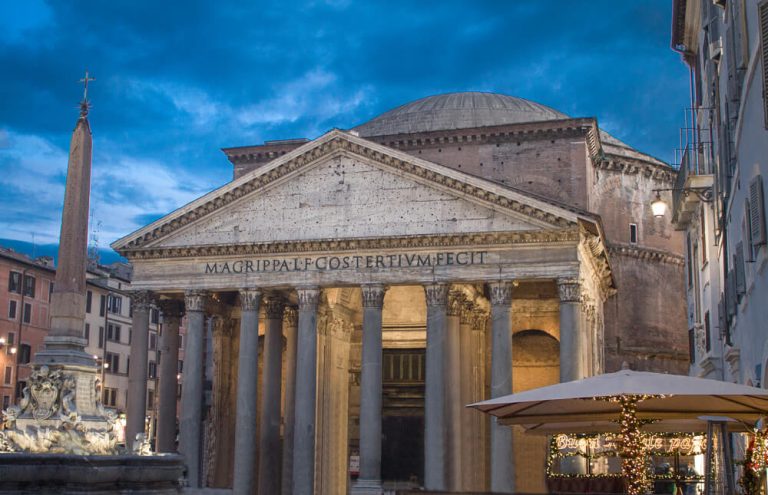
Trevi Fountain in Rome
The Trevi Fountain in Rome is an eighteenth Baroque fountain in the Trevi district of the city. It was actually built on the site of one of Rome’s oldest water sources, dating back to Roman times. The monument stands at over 26 metres tall and nearly 50 metres wide. Superstition has it that if you drop a coin into the fountain, you will be guaranteed to return to Rome. It’s perhaps not a surprise then that the fountain is full of coins! The latest estimate was that over €1.5 million is thrown into the water each year. This is then distributed by a Roman Catholic charity.
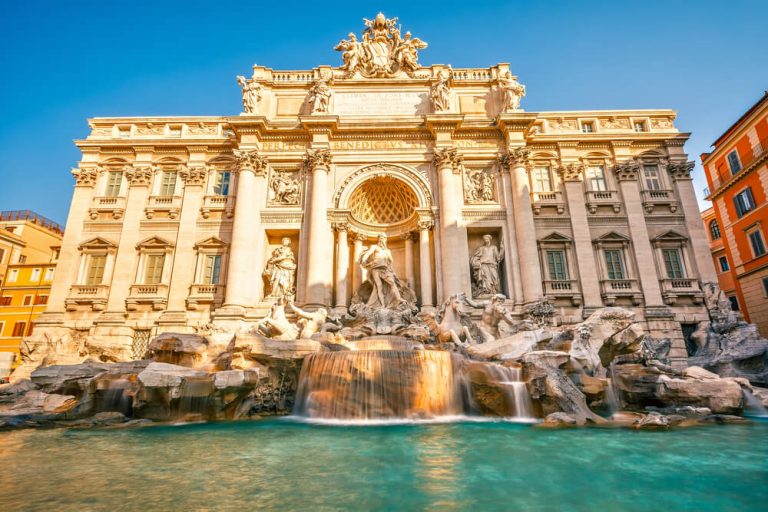
Cinque Terre
The Cinque Terre is a collection of five ancient fishing towns which are nestled on the Italian Riviera south of Genoa. The best way to explore them is to hike from one to the other. But you can also access them all by boat or by train. The largest of the villages is Monterosso. However, Vernazza is many people’s favourite. We think Riomaggiore and Manarola are just as picturesque but if you prefer something a little quieter, opt to explore Corniglia instead.
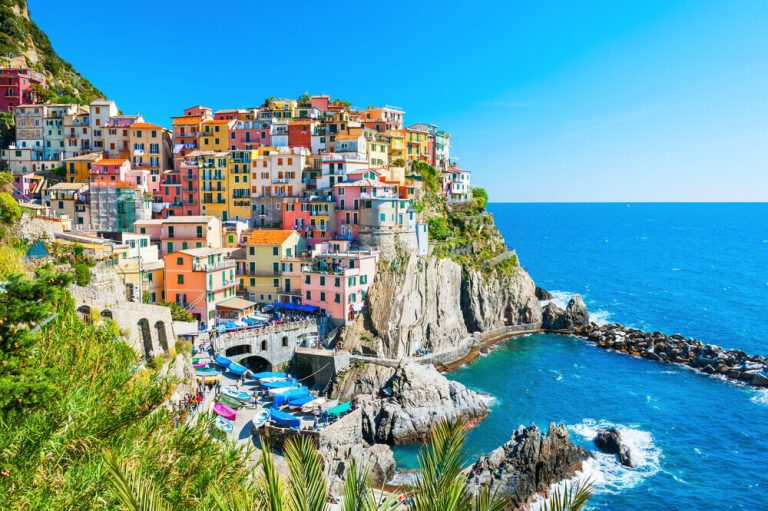
St Mark's Square in Venice
The Piazza San Marco is the largest and most famous square in Venice. It is also home to the stunning St. Mark’s Basilica, the Doge’s Palace and the Campanile (bell tower). It is affectionately referred to as the ‘drawing room of Europe‘, thanks to its rich historical and cultural significance. Lined with a number of cafes (including the famous Cafe Florian), it’s also a great spot to enjoy a drink and some people watching. Expect to pay inflated prices but we think it’s worth doing at least once in your life!
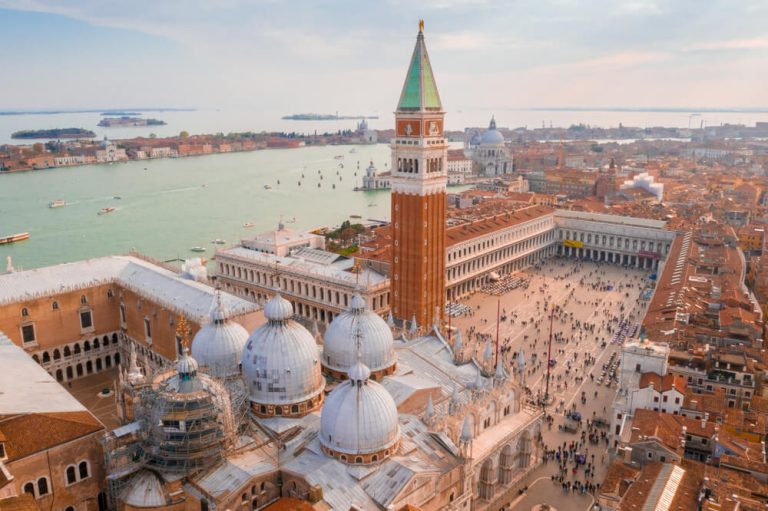
St Peter's Basilica in Rome
St Peter’s Basilica is just one of the monuments in the Vatican city, the headquarters of the Roman Catholic church. It took over 100 years to build and was completed in 1626. Designed by key Renaissance artists such as Donato, Michelangelo and Bramante, it is arguably the best example of Italian Renaissance architecture. It is purported to be the burial site of Jesus’s apostle Peter. His tomb sit directly below the Altar of the Confession.
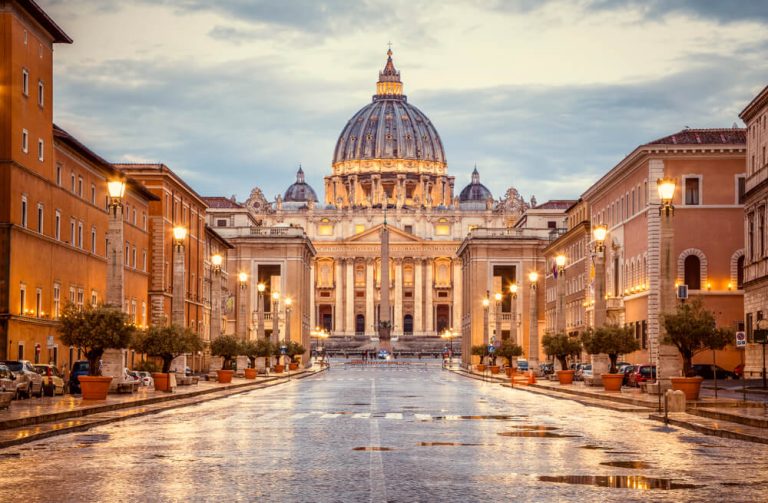
Galleria Vittorio Emanuele in Milan
Named after Italy’s first king – Vittorio Emanuel II – and built in the nineteenth century, this is Italy’s oldest shopping arcade. We think it’s also the most beautiful place to shop anywhere in the world! It is filled with high end designer stores. It also connects the Piazza del Duomo to the Piazza della Scala.
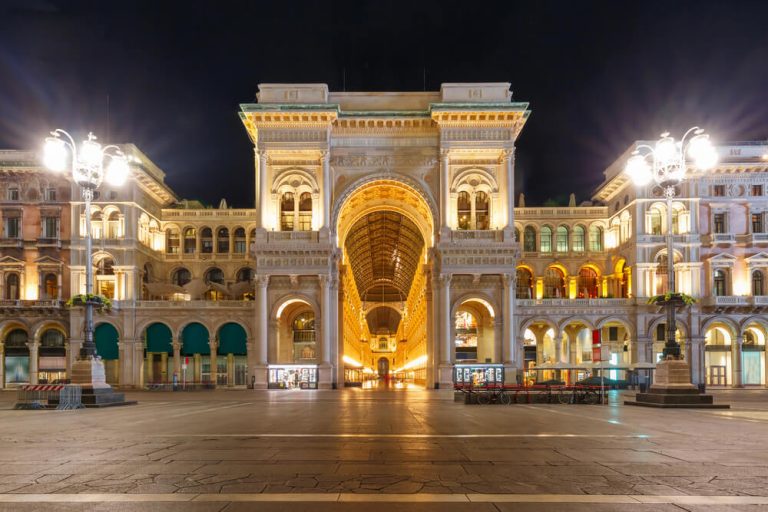
Ponte Vecchio in Florence
The Ponte Vecchio is by far the most famous of the 12 bridges that span the River Arno in Florence. Dating back to 1345, it is also the only bridge in Florence that was spared destruction in the Second Wold War. Back then, it would have been lined with butchers, fishmongers and leather artisans selling their wares. These days it is lined with rather more expensive jewellery and goldsmith shops
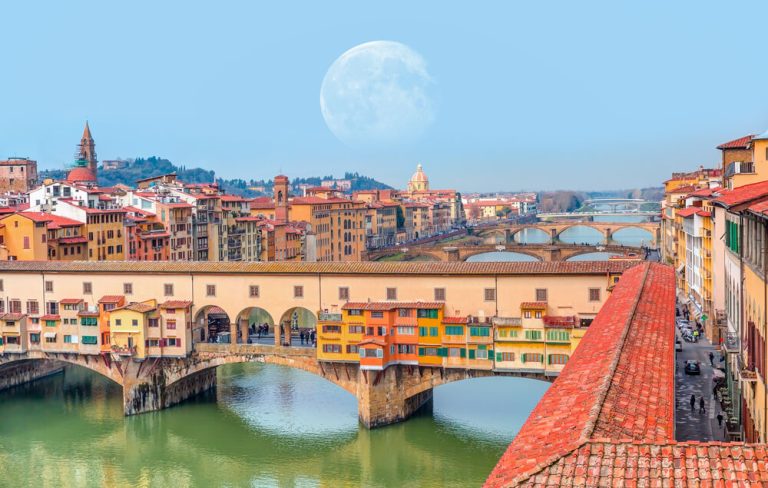
Lake Como
Lake Como’s popularity has lasted for centuries. It was once a stopping point on the eighteenth century European Grand Tour before visitors continued their journeys to Milan, Florence, Venice and Rome. It’s famous for its picturesque lakeside towns as well as for its stunning villas and gardens. These include Villa Carlotta, Villa Bernasconi, Villa d’Este, Villa Erba and Villa del Balbianello. The landscape is stunning and it’s therefore not surprising that it is often referred to as the most beautiful lake in the world.
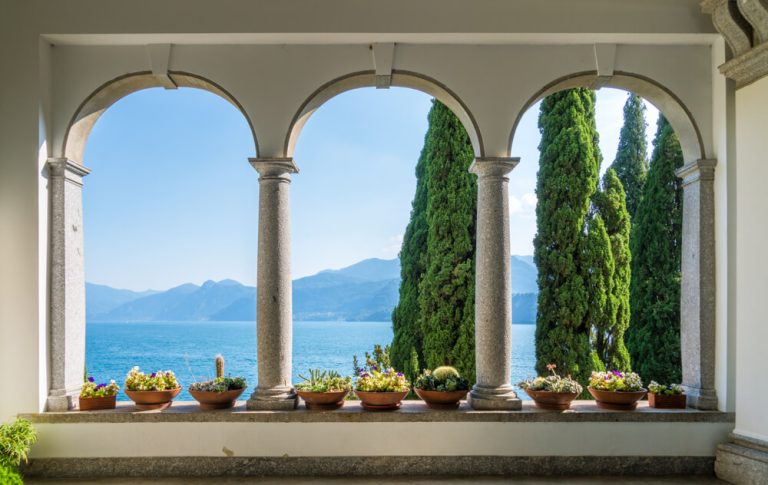
Verona
One of Italy’s UNESCO World Heritage sites, Verona is home to Italy’s third largest amphitheatre – the Arena di Verona. It’s also home to the star-crossed lovers Romeo and Juliet. Visitors can visit the famous balcony at the House of Giulietta. Verona’s two main squares are the Piazza Bra and the Piazza delle Erbe.
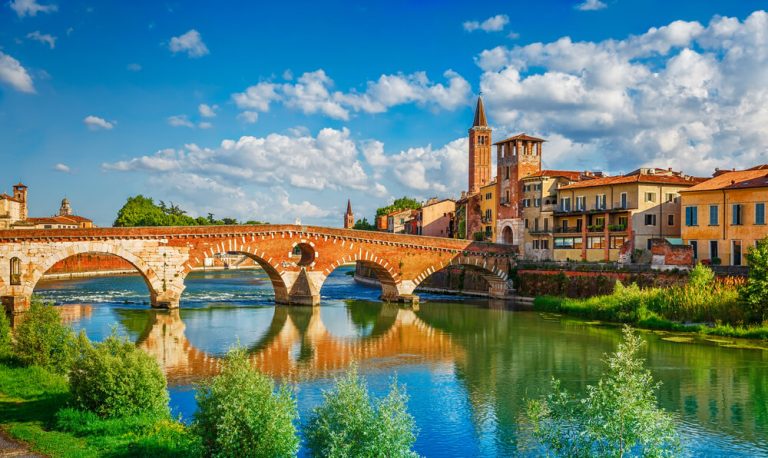
Amalfi Coast
The Amalfi Coast is a breath-taking stretch of Italian coastline in the Campania region of Italy. Awarded UNESCO world heritage status as an outstanding example of a Mediterranean landscape, it is 34 miles long and covers an area of over 11,000 hectares between the Gulf of Naples and the Gulf of Salerno. The rugged cliffs of the Amalfi Coast overlook the Tyrrhenian Sea and the Gulf of Salento below, offering visitors some of the most magical vistas anywhere in Italy.
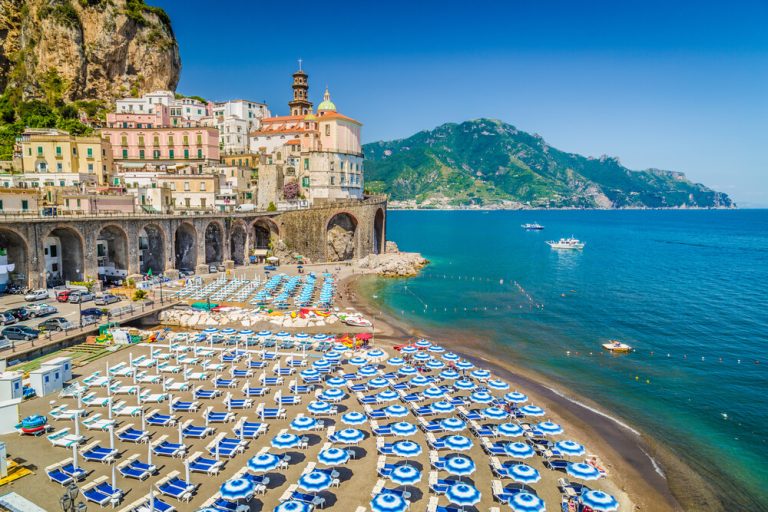
Duomo in Milan
The Duomo in Milan is the largest cathedral in Italy and the fifth largest Christian church in the world. Work started on the building in 1386 and, over 600 years later, it was finally completed in 1965. The result is a building which incorporates a vast number of different styles of architecture. It is decorated with 3400 statues, 135 gargoyles and 700 figures.
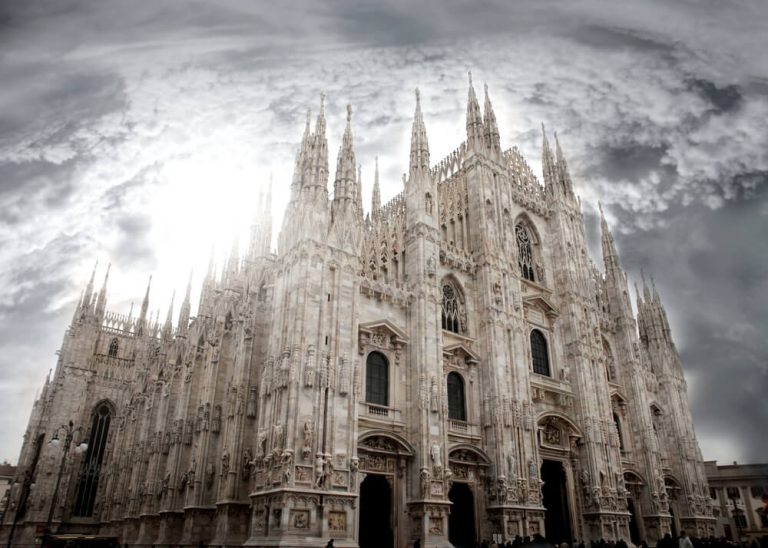
The Accademia in Florence
The Accademia in Florence is the fourth most visited gallery in Italy. It is also home to the largest collection of Michelangelo’s works in the world. The most famous of these is definitely the statue of David. A replica of this statue stands outside in the Piazza della Signoria but if you want to see the original, you need to head inside. Other works by Michelangelo in the Accademia include the four works of the Slaves or The Prisoners, St Matthew and the Palestrina Pieta. There are also works by Fra Bartolomeo, Botticelli and Ghirlandaio.
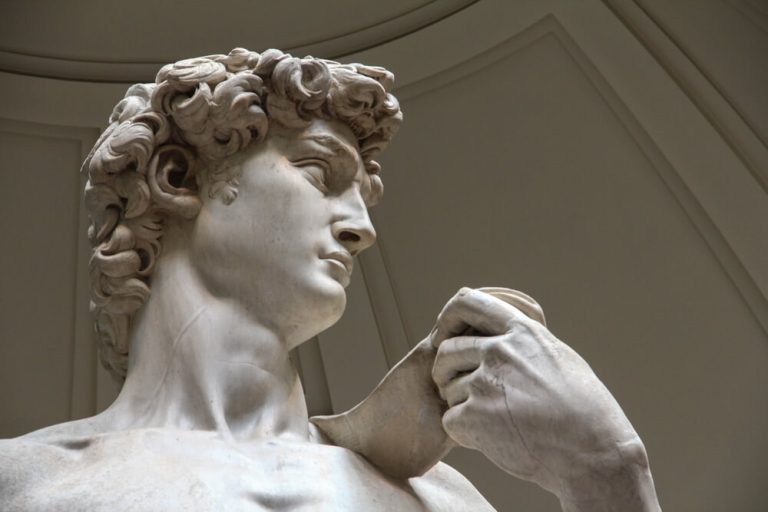
Sassi of Matera
There are 12 bridges in Florence, each spanning the River Arno. But by far the most famous is the Ponte Vecchio. The bridge dates back to 1345. Once upon a time, it would have been lined with butchers, fishmongers and leather artisans selling their wares. These days it is lined with jewellery and goldsmith shops and links the historic centre of Florence with the Oltrarno district on the other side.
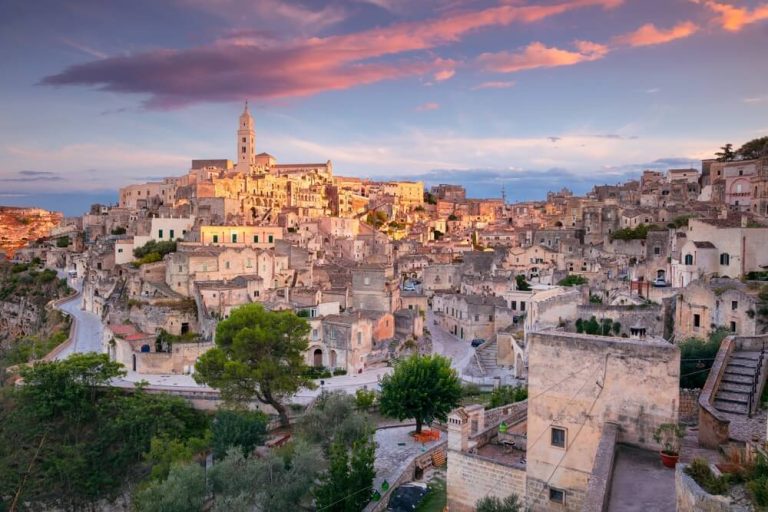
Sistene Chapel
The Sistene Chapel is a chapel within the Apostolic Palace, the pope’s official residence in the Vatican city. Visitors can enjoy a visit by purchasing a ticket to the Vatican museums. The chapel itself was built between 1477 and 1480 by Pope Sixtus IV. The ceiling was then painted by Michelangelo on the commission of Pope Julius II between 1508 and 1512. It depicts a number of biblical scenes, of which the most famous is the Creation of Adam. The museums are home to a vast wealth of incredible art, not just the Sistene Chapel. However, it can attract as many as 20,000 people a day in peak Summer months. So we can’t stress enough what a difference it will make to have skip-the-line tickets for entrance here.
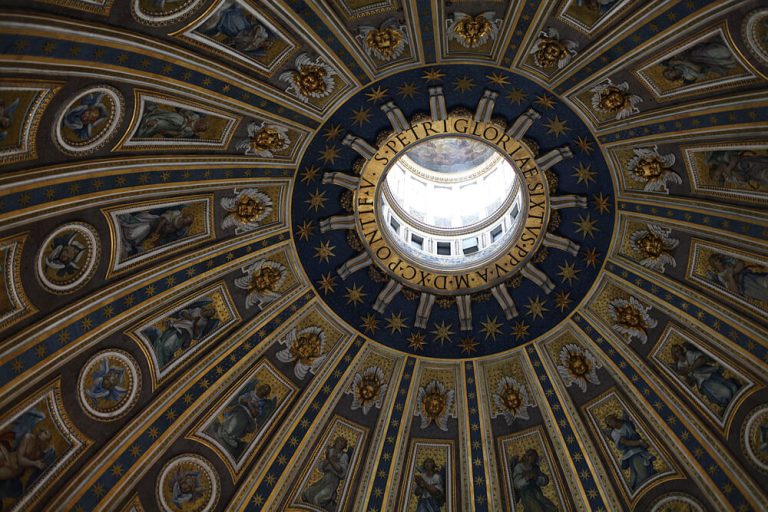
The Best Time to Visit Italy
Weather wise, there is no reason why you can’t visit Italy at any time of year. Most of Italy has a Mediterranean climate and its relative mildness 365 days of the year means it’s definitely a country that can be visited ‘off season’. Don’t forget that Italy is home to a number of ski resorts too so it’s also a great destination in the Winter months if you enjoy snow sports.
Temperatures are hottest in the South. Opt for a villa in Puglia or Calabria and you can expect to enjoy over 300 days of sunshine each year. Temperatures can soar in the peak Summer months of July and August, often surpassing 30 degrees. The main towns and cities here can become almost stiflingly hot and visitors will find that they can be pretty sleepy places during the heat of the day. Instead, they come alive at night when temperatures have cooled. However, it’s always much fresher by the coast and with miles and miles of golden sand and beautiful beaches to enjoy, it’s heaven for sun worshippers!
Further North, in the central belt, Lazio, Tuscany and Umbria enjoy a relatively mild climate all year round. Again, temperatures will peak in the key Summer months, as will visitor numbers. The cities here can be pretty stifling if sightseeing in these peak Summer months. You’ll find it cooler and more refreshing in the hills and on the coast.
In the North, opt for an Italian Lakes villa and you shouldn’t tend to see the humidity that you can get further South. However, even up here, the climate is mild all year round, evidenced by the numerous tropical plant species you will find in the ornate lakeside gardens.
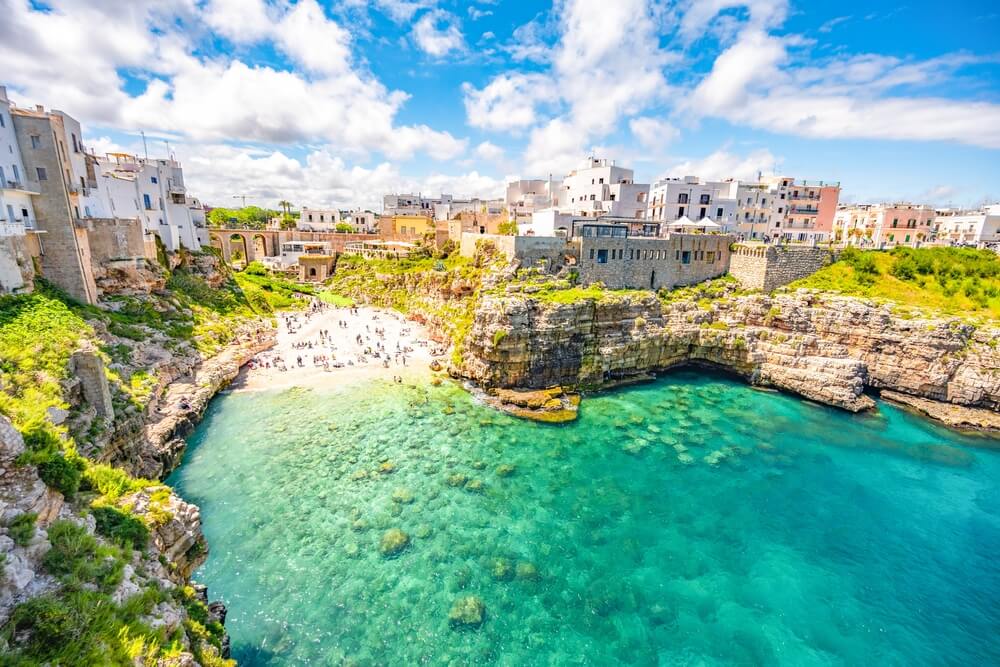
Because of its popularity, Italy’s main tourist centres can get busy in the main Summer months. Italy’s cities are certainly much quieter (and cooler!) in the Autumn and Winter months or in the Spring time which can make sightseeing much more pleasant. As a result, we recommend that you visit Rome, Florence, Venice or Siena out of season. This way, you also will avoid the queues to the museums and the crowds of holidaymakers.
Italy also enjoys many festivals across the Autumn and Spring months so this can be a great time to visit, especially if you want to absorb some Italian culture. Read all about the festivals and events in Italy here. Or if you’re looking for some warmth to get you through the long Winter, you could head to Puglia in October and November, when it’s not unusual to still enjoy temperatures in the low twenties. It’s still a great time of year to enjoy the beach too.
However, don’t let the crowds put you off travelling in the peak Summer months. July and August are the busiest months in Italy. This is when you will find many Europeans visiting the country. Italians typically take their holidays in August when many leave the heat of the cities to escape to the cooler lakes or coastal regions. Every year, on 15th August Italians celebrate Ferragosto, which is perhaps the most eagerly anticipated day in the Italian summer calendar. It’s a national public holiday and Italians celebrate with parties, wonderful feasts and spectacular fireworks displays.
How many days do you need in Italy
At Bookings For You, we’ll happily help create a bespoke itinerary for your Italy villa holiday. After all, an itinerary will vary dependent on the location of your villa in Italy and whether this is your first visit or whether you’re returning seasoned holidaymakers.
3 days in Italy
Three days in Italy is certainly not enough to do justice to it, but we can pretty much guarantee that it will be one of the most enjoyable 3 days you have recently spent!
Choosing where to stay in Italy for just three days is an almost impossible task. However, it’s worth considering a city break. There are so many cities in Italy worth visiting. Opt to explore the canals of Venice, the galleries and museums of Florence or the incredible history of Ravenna. Alternatively, you could opt to explore the sassi of Matera, the Roman remains in Rome or the culture of Milan. Or, maybe the vibrant food scene of Palermo, Parma or Bologna is more your vibe.
Whichever city you choose, there will be more than enough to occupy you for 3 days. However, if you did want to escape the city, there are plenty of day trips you could opt to enjoy too.
A week in Italy
Most of our Italy villa rental clients probably spend a week in Italy. Whilst many of us would love to explore for longer, the realities of work, school and money means a week is often all the time people have. However, a lot can be done in a week!
A lot of the itineraries you find online will suggest a number of bases for a week in Italy. For example, they may suggest that you spend 3 nights in Rome, 2 nights in Venice and 2 in Florence. They may even suggest you squeeze in visits to Verona, Pisa or Siena in between! However, we feel that trying to do all three of Italy’s cities is often short-changing each place. This whistle-stop tour really isn’t time to do justice to any of them. Plus, if you’re just travelled in from the USA or further afield, it doesn’t factor in just how tired you will be with jet lag. Suffice to say, we have seen too many couples struggling to keep their eyes open over a steaming bowl of spaghetti carbonara in our time!
Instead, we recommend a quite different approach. We’re big fans of slow travel. Slow travel is a way of travelling that places the emphasis on a much more relaxed, more mindful approach to exploring. It is all about taking the time to connect more deeply with a place, its people and its culture. It’s about the appreciation of the journey rather than a tick box exercise to see as much as possible.
As a result, if you have a week in Italy, we recommend you choose a single base and explore from there. Whether that’s Tuscany, the Italian Lakes, Puglia, Umbria, Emilia Romagna or somewhere else doesn’t matter. No part of Italy will disappoint. Opt for this approach and you’ll find little known gems that make for your own unique memories, versus ticking off a laundry list of tourist sites. You may feel that you’re ‘missing out’ but, trust us, you’ll find so much more to enjoy when taking things slow!
To take just one example, you could opt for a week in one of our villas in Tuscany. Let’s imagine you’ve chosen a villa near San Gimignano. You could spend one day exploring San Gimignano itself, another in Florence and another in Siena. One day might be spend in the Chianti vineyards enjoying a wine tasting or a cookery class. Another may be spent on the Tuscan coast enjoying a day at the beach. Another morning could be spent shopping for groceries at the local market followed by an afternoon at your private pool. The possibilities are endless…
A fortnight in Italy
If you are lucky enough to have 2 weeks in Italy, then you may actually just want to slow down our 7 day Italy itinerary and enjoy a slower pace of travel. However, if you are keen to explore more, then it’s worth considering a twin centre stay too. Each Italian region has its own unique character and charm. As a result, having two bases can almost feel like you’ve had two completely different holidays.
As an example, you could spend the first week in an Italian Lakes villa before heading down to Tuscany for your second week. The drive between Milan and Florence is less than 4 hours. But if you want to get there faster, the high speed train will get you there in less than half that time. Alternatively, you could spend the first week in the Italian Lakes and then catch an internal flight from Milan to Bari to enjoy a week in Puglia. Or maybe you fancy a week on the beautiful Amalfi Coast before heading to Sicily for your second stop. An overnight ferry conveniently takes you from Naples to Catania if this itinerary appeals. The choices are endless!
A month in Italy
If you can spare the time, then a month in Italy will allow you to explore the country from top to bottom, whilst still enjoying the slow pace of travel that we recommend.
Spend your first week exploring the Italian Lakes. Pick just one of the lakes as your base for the week and then make day trips from here if you want to explore further afield. Our recommendation is Lake Maggiore. It tends to offer better value for money when it comes to accommodation but it’s also ideally nestled between Lake Como and Lake Orta, allowing for easy day trips.
Spend your second week in Tuscany. There are so many Italian cities here worthy of a visit that you will need a week to do justice to the region – Pisa, Florence and Siena for example – as well as a wealth of smaller towns and villages. But no trip to Tuscany would be complete without exploring its rural landscape too. Whilst in Tuscany, it’s an easy day trip to the Cinque Terre. This is a collection of five villages that literally seem to cling to the rocks of the Italian Riviera. Alternatively, you could also opt for an overnight stay here too. Enjoy the beautiful coastal paths that lead from one village to another, stopping half way for the night.
You have a couple of options for the third base for your month in Italy. You could head to neighbouring Umbria or Marche. Both are just as beautiful as Tuscany but arguably offer a quieter, more authentic stay away from the crowds. Alternatively, you could head to the chic seaside resorts of the Amalfi Coast. Along with the glitz and glamour of villages here such as Positano, Amalfi, Capri and Ravello, it’s also an excellent base from which to discover the incredible history of Pompeii.
No visit to Italy would be complete without time spent in the country’s capital Rome. Whilst it would take at least a week to see everything in the city, a 2 night stay here is sufficient to see the main sights.
Finally, it’s time to escape the hustle and bustle of the city and head to your last couple of bases. Spend at least a few days in Puglia. The region differs quite significantly from north to south but, for first time visitors, we recommend opting for an Italy villa in its central swathe in the Valle d’Itria. Try to base yourself near Ostuni, Alberobello, Locorotondo or Cisternino. Use Puglia as a base to enjoy a day trip or overnight stay in Matera in neighbouring Basilicata. This unique city is well worth making a detour for.
And finally, if you have time, you have the option of heading across the water to Sicily too. Sicily is the largest of Italy’s islands. Even if you spent the whole month in Sicily, you couldn’t see it all. But a few days here will allow you to dip your toe in and at least visit a couple of the island’s highlights.
Discover more in our complete guide to spending 4 weeks in Italy.
Italy holidays for...
At Bookings For You, we’ll happily advise you on the best location for your Italy villa holiday. Whilst we would argue that there is no bad region of Italy, different places will appeal more to some than others. Let us know what your interests are and we’ll let you know which regions we think you’ll enjoy most.
For Couples
A city break in Italy can be a great option for couples. Opt for a stay in Florence, Rome or Venice or instead choose one of the smaller towns and cities such as Verona, Siena or Matera.
Alternatively, if you’re looking for a romantic break in Italy, consider the picturesque Chianti countryside in Tuscany. Or opt instead for the beautiful backdrop of the Amalfi Coast’s picturesque clifftop villages, the idyllic beaches of Puglia or the sparkling waters of the Italian Lakes.
For Families
We recommend renting a villa with pool in Italy if you’re holidaying with children. Whilst there is so much to see and do in Italy, they will thank you for time spent relaxing poolside!
If travelling with young children, we’re firm believers that if the kids are happy then the parents will be too! As a result, make sure you pick an Italian destination where there is plenty for them to enjoy.
We think the Italian Lakes has much to offer families. However, whereas Lake Como and Lake Orta are arguably better suited to couples or an older generation interested in historic homes and gardens, Lake Maggiore has a wealth of things to interest younger ones too. These include the array of water sports, the lakeside lidos, the animal and adventure parks and more.
Or, if your children love spending time on the beach, you may want to consider a villa in Puglia. The beaches here are terrific. Whilst Tuscany can also boast some incredible coastline, we have tended to find that more of Tuscany’s beaches have been taken over by beach clubs where you need to pay for access, something that doesn’t always work as well for families with young children.
In reality though, there is no ‘bad’ area of Italy for families. In Italy, family is paramount. Strong family ties are important and Italians love children and babies unashamedly. Italy is an extremely welcoming destination, full of family-friendly activities that will keep the whole family entertained.
Wherever you opt to stay on your next Italian villa holiday, Bookings For You will be happy to provide you with an itinerary of days out that everyone can enjoy.
Solo Travellers
If travelling solo, we recommend choosing a location with good public transport links. Whilst driving in Italy is easy for the most part, it can definitely be stressful if travelling on your own. Instead, we think it’s much more relaxing to go by train. Choose a location with excellent train links and easily accessible train stations.
Alternatively, if you’re looking to meet others during your travels, a city break in Italy can be a great option. Staying in a larger town or city can make it easier to connect with fellow travellers and experience the city’s culture as part of a larger group.
For Groups
We think that renting a large villa in Italy in the heart of the countryside is a great option for groups. You’ll be able to enjoy the privacy and space that a self-catering villa offers and won’t need to worry about disturbing the neighbours!




